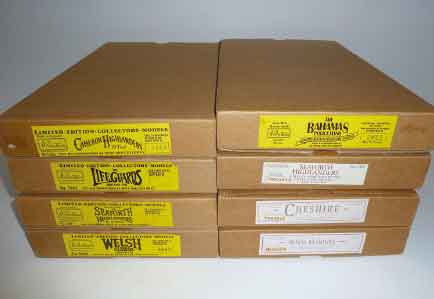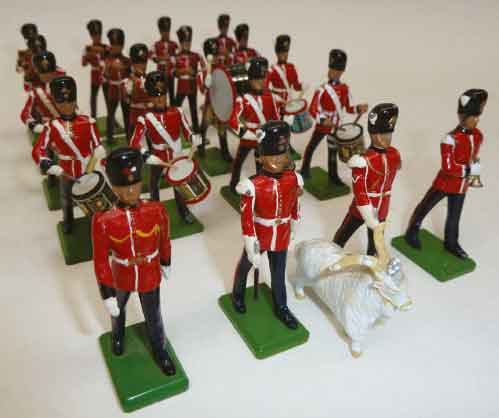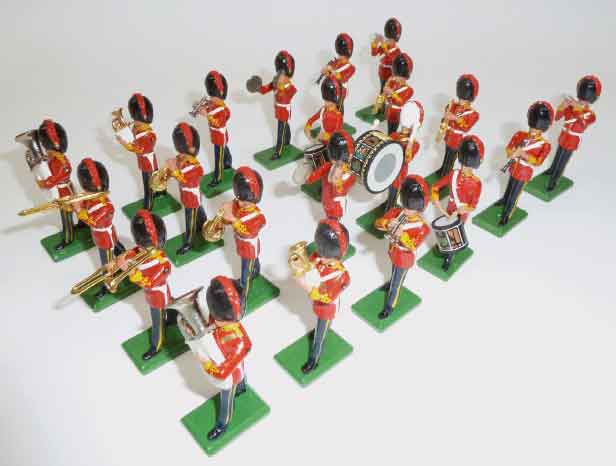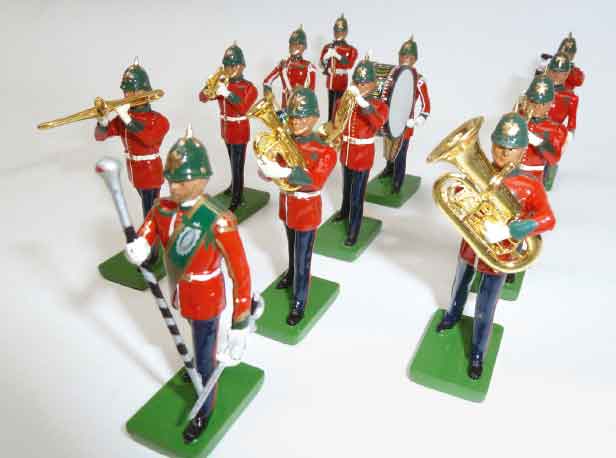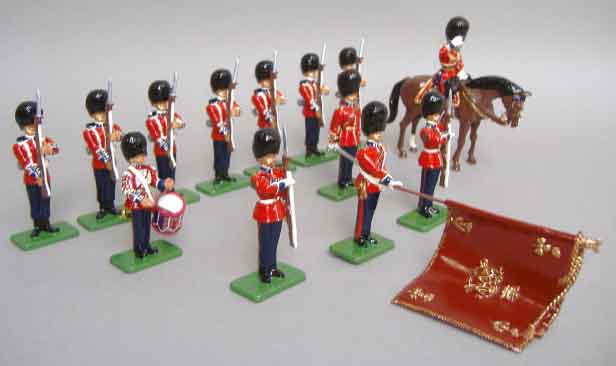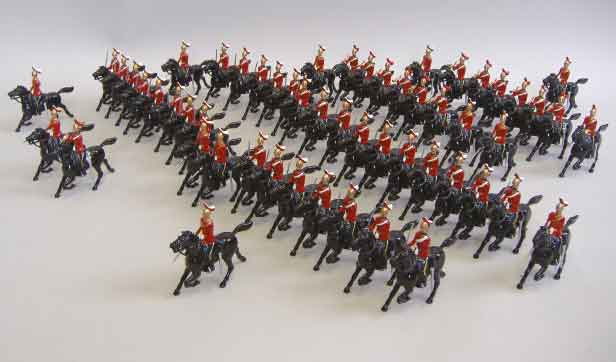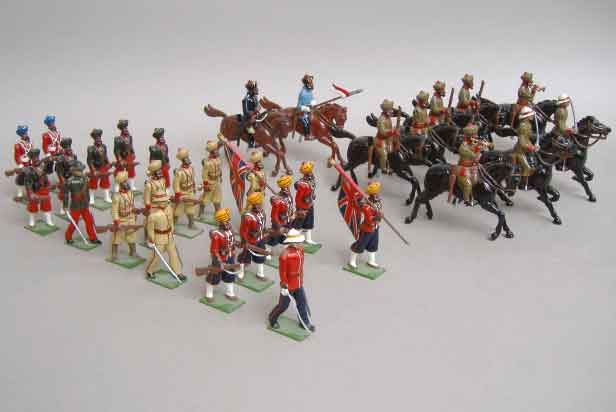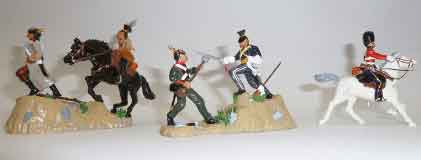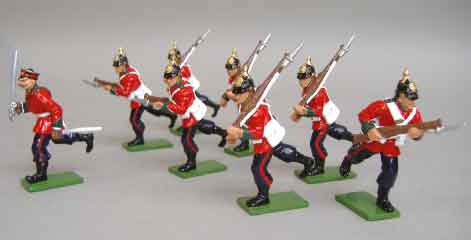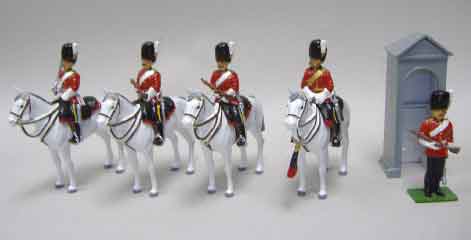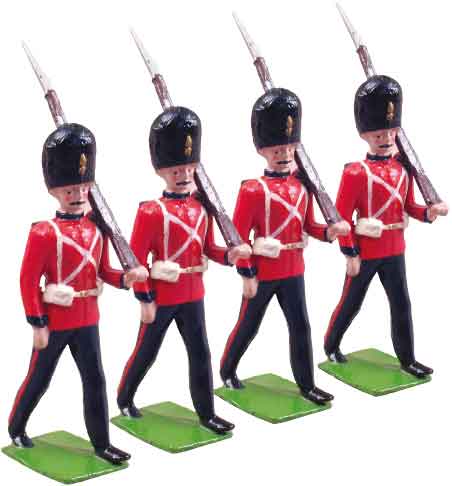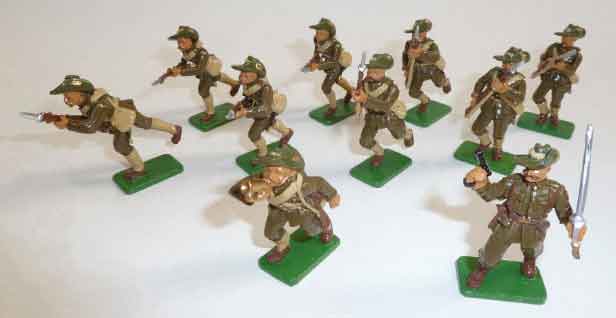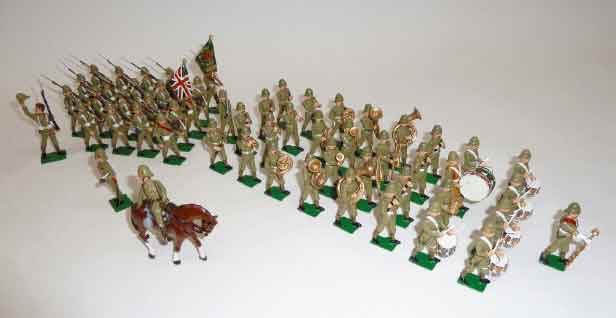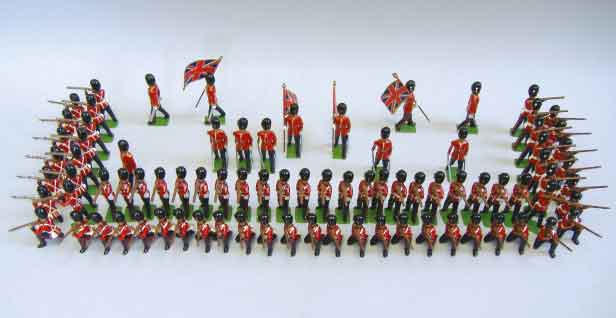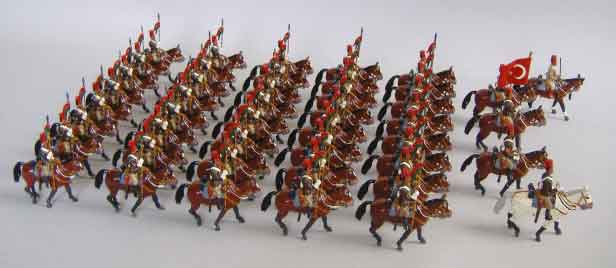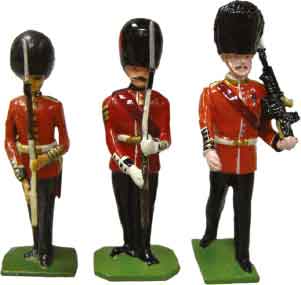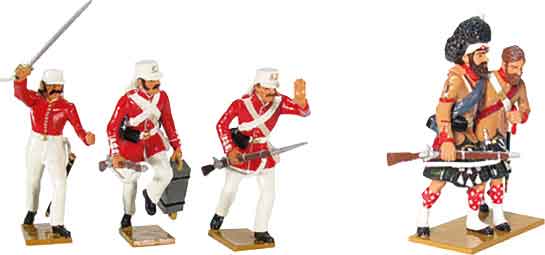The Sixth Age of Britains –
Collector’s Toys 1983-1998
Nostalgia and Re-living the Dream, The William Britain Collectors Club, Marketing to collectors and the development of the New Toy Soldier.
Although Britains models had always had the attributes of an adult collectable, until 1983 they had always been presented through established toy trade outlets as children’s toys. From 1983, the boundary became more blurred with the first issue of limited edition sets of toy soldiers primarily aimed at adult collectors. This was only following on similar issues by toy car and train manufacturers, as well as the new toy soldier manufacturers that had become numerous since 1973. Over this previous decade, however, Britains had neglected to capitalise on a fairly obvious extension of their production capabilities, and had allowed those with whom they were about to compete a decade’s head start.
During the next three decades from 1983, the Britains brand, under various ownerships, was to enter every corner of the new markets in toy and model soldiers that technology, marketing and the increasingly integrated world economy were opening up. Britains started off by developing their own distinctively individual range of die-cast Metal Models. These were directed to collectors through the medium of the Collectors Limited Editions, with an initial push from Reeves, Britains long time US distributors. Then, in 1990, Britains tried, not unsuccessfully, to revive the old style of hollowcast toy soldier by using diecasting to reduce cost to a level where there would be sufficient margin for both marketing and profit. The effect was multiplied by the centenary inauguration of the William Britain Collector’s Club in 1993.
After that, it was the pressure of a myriad of competitors in a market where the entry level hurdles were comparatively low that motivated those looking after the Britains brand to try for greater diversity of product. This was achieved through subcontracting a fair amount of short run design and production to some of those same competitors, thus maximising the number of sets which could be sold to those who wished to collect every item issued under the Britains brand label. As the trend in toy soldiers changed towards an adult market and more and more towards realism and military modelling, so the Britains brand followed closely behind, enabling it to retain its status as the market leader. Many new initiatives were undertaken, the most significant being to start production of out and out matt painted models of the American Civil War in 1999. Developments from that move deserve the next chapter to themselves as the Seventh Age of Britains.
To emphasise how the market in toy soldiers swung from mass-market toys in 1973, to collectors toys today, a little pricing comparison is in order. For a typical mass market, long production runs ensure low prices and high profits through economies of scale, if large quantities can be sold. In the collectors market, counted in thousands rather than in millions, low quantity runs have to be offset by wider product range and higher prices to produce equivalent profits. In 1973 a New Metal Guardsman cost 10p, not a great deal more than a hollowcast figure ten years earlier. By 1983, the new highland figures were retailing at 99p each. In 1993, when I finished The Great Book of Britains, a Metal Model cost £2 in the shops. Today, twenty years later, a Scots Guard of the Ceremonial Collection is £4.99. Over these forty years, the retail price index has increased by roughly 800%, but the price of a Britains Scots Guardsman has increased by 5000%, over six times the rate of inflation, thus transforming the price from the toyshop to the specialist outlet for collectors or tourists.
Auction lots of Metal Models on foot can be acquired at auction for about £2-3 per figure, but acquiring what you actually want from the backlist at shows, without original boxes, is likely to cost more like £5-7 per figure for infantry, and that is if they happen to be available. The curious thing is that this is not that far removed from the price for the more common older hollowcast toy soldiers.
This chapter deals with ‘New Toy Soldiers’, reproduction old toy soldiers and limited editions, all made for collectors. For the earlier figures made during the period 1973 to 1993, resale values at auction are on average a quarter of the original price allowing for inflation, or half the original actual price at retail. Of the models, dealt with in the next chapter, very few have yet come back onto the market. Because of the way they have recently been presented, with ever shorter availability periods, they are better tailored to being missed by collectors, with many new entry collectors still playing catch-up with the earlier models in the various subject areas.
Britains product for collectors of toy soldiers can be divided into three types: that which continued to build on the diecast New Metal figures originally produced for the toy and souvenir markets, that which was aimed squarely at collectors of traditional Britains hollowcasts and finally that which fitted with neither of the above, attempting rather to sell on the Britains name and through the excellence of the figures as part of the New Toy Soldier market.
New directions with changes of ownership
There have been four changes of owners and management teams for the W.Britains brand of collectable figures since the Britains family relinquished control in 1984. Each new team has had to revisit decisions on distributing resources between toy, souvenir and collector markets, the best way of supplying these, the balance between the military and civilian models and the most profitable manufacturing and pricing policies compatible with quality production. The answers decided upon have from time to time involved quite sharp changes. (See also the article on page 348)
Products for collectors of Britains New Metal figures
Britains Limited Editions 1983-present
The sets were very nicely packaged, and sold at premium prices. The quantity of sets to be offered was announced in advance, and this was the quantity that was manufactured. The figures included were initially based on the New Metal series, and only departed from this style in the sets commemorating campaigns during 1996-1999. These campaign sets differ from the others sufficiently that collectors might not wish to include them in a complete run of the series.
Picture 251: Limited Edition outers 1983-1989
The first eight sets of the Limited Editions in their thick cardboard packing outers suitable for sending through the post if necessary. The first five Limited Editions had bright yellow labels, mirroring the illustrated box labels inside. After these came a long series of nicely illustrated individual labels on a very pale pink background (see picture 252). The outers for the first three of these, with their matching end of pack labels, are illustrated here. This makes it easy to spot the first five sets, as the next twenty-five sets through the year 2000 all bear the pink labels. B
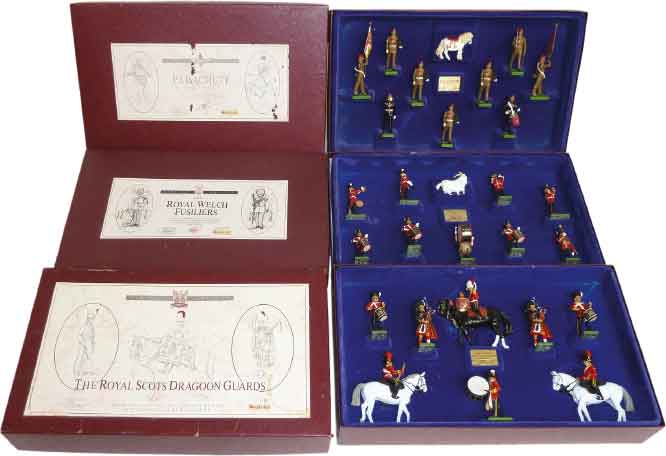
Picture 252: Limited editions 5190, 5290 and 5191
The numbering means that we have here the first and second limited editions of 1990 and the first of 1991. The Parachute Regiment was the first Limited Edition to include a mascot, and the next two are the Royal Scots Dragoon Guards and the Royal Welch Fusiliers. Picture 253 below appears to be made from four sets of 5290, and picture 254 below from an awful lot of sets 5290. This latter is not true, as conversions have been employed. The flock sprayed vacuum formed tray into which the figures fit in these sets makes it easy to take them out and put them back. The Parachute Regiment box here has a torn label, and because there are so many sets available which have never been taken out of their outers, this sort of damage will affect the price severely. B
Picture 253: Royal Welch Fusiliers drums and fifes from set 5191
As always, lots of toy soldiers look much better than just one set. It would need four sets (each including two fifers) to make up this band, and there looks to have been some conversion going on in addition. Note the not matching drums and the bugler. Everything looks a bit knocked about. Figure front and left could be from set 5193, Royal Fusiliers. B
The first Limited Edition brought out in 1983 was set 5183, Cameron Highlanders, produced at the request of Reeves International, Britains distributor in the United States. The Britains management were quite surprised by the request, but since Reeves were paying, they produced 3,000 sets for a standard price and were astonished when Reeves sold out almost instantly at a handsome profit. Thus Britains were encouraged to start a Limited Edition series that has continued in various forms ever since.
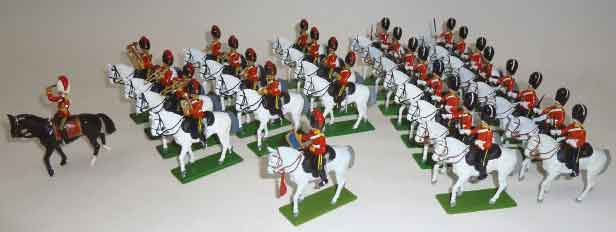
Picture 254: Scots Greys conversions from New Metal figures
In addition to the Limited Editions, collectors were not slow to use surplus figures to convert, as in this imposing array of Scots Greys. Unfortunately the kettledrums are missing in this otherwise well finished group of mounted band and troopers with carbines. B
Picture 255: Scots Greys Band on Foot
This picture shows why Britains turned to larger bands in their limited editions from now on. This was the last of the original style bands based on the Metal Model series, and the set, number 00102, had just thirteen musicians included. Two sets have been used to make up this picture, although both drum majors and three other musicians are missing from the complete two sets. The number of this set, 00102 was the first Limited Edition series set that did not use the four figure number starting with five and containing the year of issue, which in this instance was 1999. The overall effect of the group is good, but one doesn’t need two cymbalists, bass drummers or drum majors to make up a larger band. B
The second Limited Edition was a set of six Life Guards modified with metal swords rather than the plastic ones normally supplied. The number of this set was 5184, and the numbering system for the Limited editions was an interesting one. All sets started with a five, and ended with the last two digits of the year of production. The second digit was the number of the set within the year. This numbering system continued through 1983 to 1988 when there were just one set issued, 1989 and 1990 when there were two sets, 1991 and 1992 when there were three sets and 1993 to 1998 when Britains went back to two sets per year. This made a total of twenty -eight sets in the series from 1983 to 1998. Thereafter, the sets were numbered within the new numbering systems that applied from 1999.
Until 1996, the Limited Editions were all of specific regiments of the British Army in various ceremonial uniforms. In 1996, however, after a number of years when the Limited Editions, in spite of reductions in the size of the edition, were not selling out, new directions were sought, and it was hoped that basing an edition on a historical occasion would yield better results. In 1994 in the Toy Soldier Series, a D-Day set had been tried with some success, and in 1995 sets commemorating V-E Day and the American Civil War had also come out, so Britains was already thinking in historical terms for collectors. The first attempt in the Limited Editions was set 5296, the Second Burma War. This colonial ‘Little War’ was sufficiently obscure that in all likelihood no-one had produced figures of it before, but equally they didn’t fit in with anything else in anyone’s collection. It was therefore not very popular.
In the following year, Britains tried again with set 5197, the Charge of the Light Brigade, a much more famous occasion which saw two innovations in production. Until 1997, the figures in the Limited Editions were always based on New Metal designs, however modified. From now on the series boundaries became much more blurred, as in 5197 the models of the five participating Light Cavalry Regiments were based on the Toy Soldier Series mounted figure, and the Russian cannon and artillerymen were short run spincast figures rather than diecast. Only two more Limited Editions, 5297 in 1997 and 00102 in 1999 were made based on the Metal Model figures. Thereafter, Limited Editions continued as a strand of Britains gloss collectors range without being distinctively similar to the Metal Models. The conclusion of the Metal Model based part of the series evidently had something to do with the change of management during the Ertl takeover.
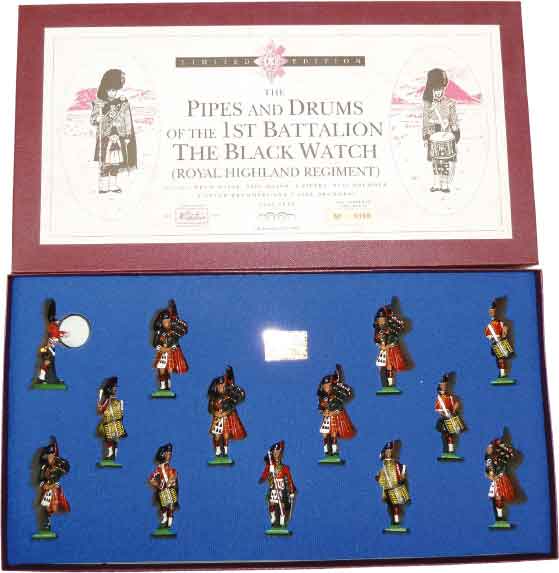
Pictures 256, 256A and 256B: Limited Edition set 5196 Drums and Pipes of the Black Watch and set 00028 Hamleys Special Pipes and Drums of the Gordon Highlanders
The set in its box, showing the later practice (from 1995) of deep cut out foam packing. This does not display the opened box nearly so well as the previous flock sprayed vacuum formed inserts. The set certainly looks magnificent once out of its box, as good in this style as the original set 2109, although you would need two of these sets to make up a band of comparable size or larger, as in 256B. 2,500 sets were made, with an additional 1,000 sets as Gordons for Hamleys. B
Historical occasion Limited Editions
There were just five of these, four of which could be said to belong to a Queen Victoria’s series which was announced with some fanfare. From this time on, many Limited Editions remained in the catalogue if they had not sold out.
Queen Victoria’s Wars Series:
5296 Second Burma War 1852
5197 The Charge of the Light Brigade, Crimean War 1854
5198 Zulu War Rorkes Drift 1879
Characters: Lt. Bromhead
Colour Sergeant Bourne
00143 Zulu War Rorkes Drift 1879 Hospital set
Centenary sets 8899 Spanish-American War and 00259 The Boer War 1900 had the same style characteristics as the Zulu War and Lawrence sets, and sit well with them. There seems to have been some hesitation in Britains managers minds as to whether the Limited Editions series should mix so much with the Centenary series, and after the Lawrence set the historical themes were dropped from the Limited Editions.

Picture 257: set 5298, Lawrence
Few legends are stronger than Lawrence, the taciturn Englishman who organised the Arabs against the Turkish Empire and helped bring about the final collapse of that once mighty entity. The figures in this set were totally spincast, and it is the only one of the historic occasion based Limited Editions not based on a Victorian war, though no-one could say that it was not moulded in the same tradition. B
5298 Lawrence and the Arab Revolt
Character: Colonel T.E. Lawrence on camel
Further Limited Editions
Apart from a distinct and rather splendid one-off Royal Horse Artillery gun team in 2001, the series settled down (with one other exception in 2003, see below) to an annual one or two large spincast band sets starting in 2000, and completing nine sets by 2006. From 2001, the RHA being the first set, sets were no longer individually numbered, but simply provided with a certificate of edition size, e.g. the Royal Artillery set was issued as an edition of 2,000, according to the certificate. The boxes also changed style at this time, coming out in full colour with a photographic montage of the contents on the box.
With First Gear taking over in 2005, a slight new direction involved the addition of smaller and colour party sets to add to the bands. These sets now (2006) took on more of the characteristics of the Redcoat and Bluecoat models with which they could be compatibly arrayed. In the meantime, it had been found convenient to announce limited editions within many other Britains ranges.
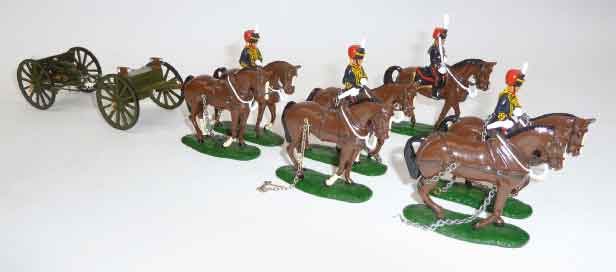
Picture 258: Limited Edition set 00261, Royal Horse Artillery Gun Team at the walk
By this time (2001) Limited Editions were mostly in various New Toy Soldier styles. This is certainly a very splendid example, limited to 1,000 sets, and not all sold in the first year. It was the third attempt at RHA at the walk, after sets 2077 (old hollowcast 1953) and 8825 (Britains Toy Soldiers 1993). It was certainly the most realistic to date, with an excellent limber and gun. The chain and hook harness was a great improvement on the lead and wire clips of the first set and the disastrously fragile diecast and wire clips of the second set. The only disadvantage of the new set was the exorbitant cost, at $300, but this was comparable with other leading makers. By now, many serious collectors were either registered dealers with a 50% discount, or made their own arrangements for lesser discounts with those who were. B
The Coronation 50th Anniversary Limited Edition 41000
Character figures:
H.M. Queen Elizabeth II seated on Coronation Chair
Geoffrey Fisher, Archbishop of Canterbury
Arthur Michael Ramsey, Bishop of Durham
Harold William Bradfield, Bishop of Bath and Wells
Alan Campbell Don, Dean of Westminster
Robert Arthur James Gascoyne-Cecil, 5th Marquess of Salisbury
Picture 259: set 41000, The Coronation 50th Anniversary Limited Edition
Limited to 2,000 sets. This was a subject that had largely already been made by Russell Gamage for Graham Farish (on the occasion) and Blenheim (at the Silver Jubilee), but as usual when Britains got around to it they were able to produce something different and at least as good in its own style as the others. B
Special Issues 1984
My 1984 exclusive order from Britains, 500 Officers and 2,000 men of the Argyll and Sutherland Highlanders was based on the standard tourist issue of the highlander and officer, the only difference being the uniform, for which I supplied the painting samples myself.
Hamleys also commissioned a number of exclusive limited editions, as well as sets exclusively packaged for them from the regular range. The most attractive of these were the Gordon Highlanders Drum and Pipe Band and Regimental Band.
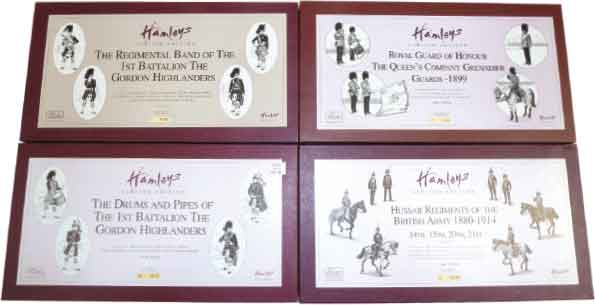
Picture 270: Hamleys exclusive Limited Edition sets
The box art for these was comparable to the regular sets. The contents were carefully chosen and executed, the limited edition size at 1,000 sets of each was relatively small, resulting in an eventual sell out for each of them, even at the premium prices charged. Thereafter they have held their value somewhat better than most other limited editions. B
The Trooping the Colour Mail Order set 1987
This was the only attempt by Britains at going direct to the public prior to the Collectors Club. It was not sufficiently successful for them to risk antagonising their distributors and retail outlets by extending the venture.
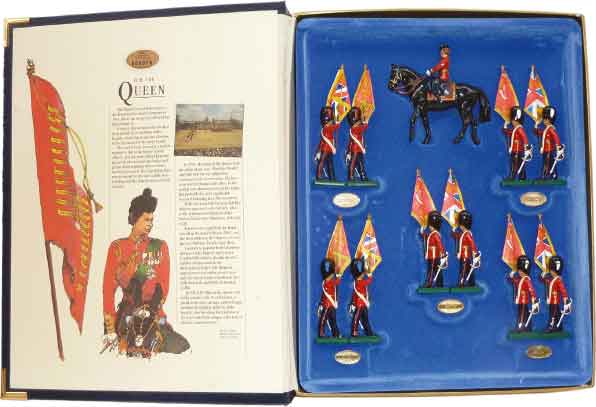
Picture 271: set 5801, Trooping the Colour
Produced in an 8,000 set limited edition (the largest limited edition ever made by Britains) this contained five pairs of Metal Model colour bearers, one for each of the foot guard regiments, as well as the standard Metal Model of the queen. It cost £60 including UK postage. Advertised as a test once only in the Sunday Telegraph, the response was not huge. Britains issued some very similar (but much better modelled) individual pairs of foot guard colours in 2012, limited to only 600 sets, priced at almost as much for each pair as this complete set had been originally. While there was no better incentive to a collector intending to acquire five battalions of foot guards, the thought of how to justify all these colours on the shelf may have put some collectors off. B
William Britain Collectors Club 1993-present
The centenary year provided a good excuse to start a new direct to collectors scheme, initially outsourced to RDP Publications, the same company that had successfully managed the Lledo Collectors Club. Initially it was thought that giving a single figure per year to build into a twelve piece exclusive band of the Sherwood Foresters would be sufficient incentive to keep members interested, but it soon became evident that members were becoming impatient, and the band of the local Nottingham regiment was finalised in 1996 with the nine other musicians. Enormous care and trouble was taken with this band, even to the extent of printing six exclusive cards to go with the six boxes making up the set with the actual membership number of the member who owned it. This proved so fiddly that it was soon discontinued for future club exclusives.
The Club was also provided with exclusive literature in the form of a bi-annual magazine The W. Britain and a W. Britain Portfolio illustrating new product for Britains collectors. The club magazine was renamed The Standard in 2001 with increased editorial content, and frequency and I contributed a dozen articles on early Britains figures.
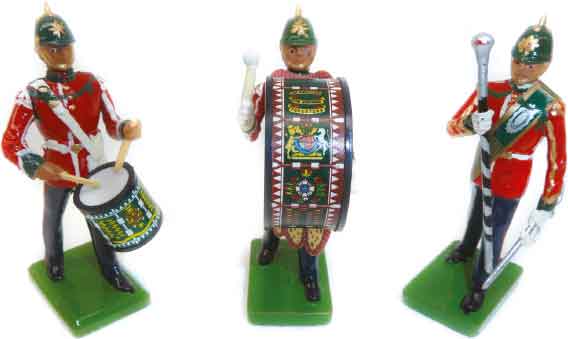
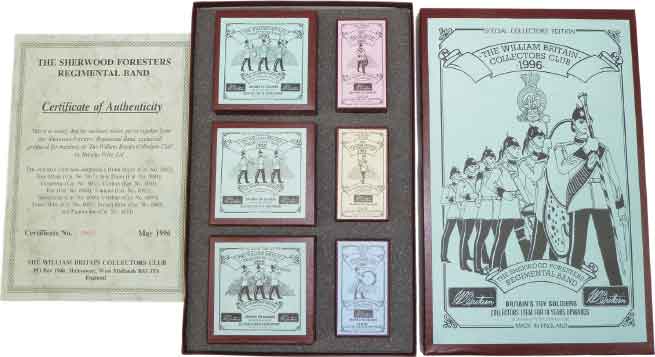

Pictures 272, 272A, 272B and 272C: The Band of the Sherwood Foresters
It took four years to complete this twelve piece set, which, it was originally envisaged, would take twelve years! The Sherwood Foresters are the local regiment to Nottingham, and probably chosen because Britains had recently moved their premises there. Picture 272 illustrates the full twelve pieces, and Picture 272A gives a better view of the spectacular drum corps figures. This was the first Britains band to be offered since the Eyes Right series. It was rather frustrating to club members to see other New Metal bands being completed earlier. No other band, however, was ever issued in a series of six boxes with an illustrated outer box (picture 272B) and six personalised certificates (picture 272C). B
The second Club exclusive set was of the RAF Queens Colour Squadron, thirteen pieces boxed with the same style of boxing and presentation as the Sherwood Foresters, but available immediately in 1997 without the four year wait. 1998 saw a similar set of the Royal Marines. This was the last of the Club figures based on the Metal Model figures. Thereafter, as with the regular Limited Editions, various figures and even series were offered as premiums or exclusives to Club members, but all were made with short run solidcast technology, indistinguishable except in style and quality from any other New Toy Soldiers.
The first non-Metal Model figure produced for the club was a character figure issued in 1996 of Dennis Britain himself, as he appeared at the 1993 Centenary Dinner, (see picture 3) based on a photograph taken there by Dr William C. McDade. He is shown holding what he had always believed to be the first Britains Life Guard with tin sword, but which was actually the second version of the figure dating from 1897 (see Picture 44, top row).
Picture 273: set 00105 Royal Guard of Honour, Grenadier Guards 1899
This set was exclusive to Hamleys, but part of the profits contributed to the cost of developing an exclusive Club venture. It was a massive layout of Queen Victoria and the Scots Guards, and this 1,000 set edition of Grenadier Guards cast from the same models allowed Hamleys to come in at the edges and help with the funding. Including this, altogether the project accounted for thirty sets, with barouche, bands, general staff and spectators. I suspect not too many complete collections of the project still exist. B

Picture 274: set 40295 State Coach
Given the many tens of thousands of Britains original state coaches set 1470 produced for the 1953 coronation, writing as I do on the 60th anniversary of that occasion it is not surprising that the resale price of most of the original ones is not at all high, at around £100 for one in very good condition. It was therefore brave of the Collectors Club to issue a new model of it that would retail for over twice that amount. The problem was that their Jubilee Procession project needed a worthy centrepiece in the right style of New Toy Soldier excellence, and it is to their credit that the result was so beautiful, including photomontages of the painted panels round the coach itself. The new model, made from the original Britains moulds but with spincast team and interior, still looks a bit clunky compared to the slighter 1470, but only when taken out of context, and because of the larger size of the horses. The complete series project weighed in at seventy sets, and I can only admire all those who stayed the course. This model of the coach contained the Duke of Edinburgh in naval uniform, as opposed to 1470, in which the Duke appeared in state robes. B
Looking at the condition of this coach, there seem to be areas of light blue where the gold paint has flaked off. I am hoping that this is not indicative of any deterioration in the metal or the finish.
In 2000, Lynn Kenwood of MKL Models took over the Club from RDP, and guided it through several ambitious years, completing the Queen Victoria Presentation of State Colour to the Scots Guards, the 2002 Queen’s Golden Jubilee Procession and initiating the annual Club Winter Limited Editions from 2002, which all came with a Christmas theme. Other exclusive items were offered as joining premiums or interesting figures to keep up the club members interest. In 2005, when the W.Britain brand was bought by First Gear, Lynn Kenwood’s contract was terminated, and the Club has since been run by the Britains marketing team in house.
Since then there have been regular exclusive products for Club members to add to the different ranges but nothing on the scale of the two projects described above, although the Christmas themed models were continued annually from 2002 to 2007.
William Britain Collectors Club and Special Character figures:
Collectors Club
3074/3075 Dennis Britain 1996
5993 HRH The Duke of Connaught 1999
00137 Sergeant Major S.W.Adderley, 1st Batt. Grenadier Guards 2000
00293 Queen Victoria, in Barouche 2000
40259 Sir Winston Churchill, in Prime Minister’s Coach 2002
40259 Lady Clementine Churchill, in Prime Minister’s Coach 2002
40295 Queen Elizabeth in State Coach 2003
40295 The Duke of Edinburgh in State Coach 2003
40343 King Henry V 2003
40320 Queen Salote of Tonga in Semi-State Landau 2004
40320 Sultan of Kelantan in Semi-State Landau 2004
40321 Sir Harold Scott, Commissioner of the Metropolitan Police 2004
40322 Major General J.A. Gascoigne, Deputy Commander, Coronation troops 2004
40322 Captain A.I. Castle, Coronation Aide de Camp 2004
40322 Captain G.R.M. Sewell, Coronation Aide de Camp 2004
40323 Colonel Sir Dermot McMorrough Kavanagh, the Crown Equerry 2004
40324 The Earl of Onslow, the Captain of the Tower 2004
40408 Napoleon 2005
43085C Florence Nightingale 2006
Specials
5891 Queen Elizabeth II seated on Coronation Chair 1993
5948 Black Hawk 1994
5900 Betsey Ross 1995
40172 Queen Elizabeth II in Garter Robes 1997
Past Editions 2000
Various surplus castings from the New Metal range and its successors were painted up and included as single figures in this clear- out attempt aimed at collectors of lines many of which had originally been sold to the souvenir and toy markets. By no means all of these appeared in the catalogue, and bulk boxed figures with unlisted numbers are constantly surfacing.
Products for collectors of Britains original hollowcast figures
By 1989, the redefining of markets between Toys, Souvenirs and Collectors had born fruit, and much thought had gone into new initiatives. Because this section is of more interest to collectors of the first four Ages of Britains, I am giving the set listings in full.
Britains Toy Soldiers 1990-2000
The start of the series
For 1990, the Britains-Petite team decided to revive for collectors the old style toy soldiers, and were given an initial boost by the existence of the original die-cast mould first used in 1947 to experiment with producing toy soldiers from the new zinc alloy material. From this, the eight available figures were three cowboys and indians, three British infantry in action, a standing firing foot guard and the classic standing on guard infantryman of the line. Four sets were issued from the original mould, and did not have embossing under the bases. A few samples were made from the cowboy and indian figures, most of which ended up in the hands of collectors.
The mould soon wore out and broke, and the experiment having been a potential financial success, new moulds were made for the first three sets, this time with embossing under the bases. Unfortunately the original mould had contained two figures in the then (1947) current full trouser style, and this was continued in the new moulds and for all future action pose figures. This would have been a perfect opportunity for all future action figures to have been in a much more attractive gaitered version. Furthermore, the standing firing figure was given a rather ugly thick new rifle barrel, presumably because the metal did not otherwise flow well to the end of the barrel.
The Britains Toy Soldiers Series most closely realised the recommendations in the report I produced for Britains in 1985, and for this reason, I chose to use these figures in 1993 to accompany my The Great Book of Britains. I asked Britains to produce figures of both regiments in their die-cast Toy Soldier style to be sold with their numbered limited edition of that book, with lances and colour bearers not available at any other time in their range. They even inadvertently made the mistake of giving the Scots Greys the same fusilier caps as the Royal Welch, which simply added to the fun, since this had been the exact same situation when Britains first issued Scots Greys and fusiliers back in 1893. I promise you this was totally unplanned, and I could not believe what had happened when I saw the first samples.
In the following listing, except where otherwise mentioned, infantry sets were six figures and Cavalry sets normally contained four figures usually including officer and trumpeter. The last year of issue is given after each set.
The four sets produced in 1990 were:
8800 Coldstream Guards standing firing (Versions without and with under base embossing) 1992
801 Essex Regiment standing on guard (Versions without and with under base embossing) 1992
8802 Worcestershire Regiment standing on guard (Versions without and with under base embossing) 1992
8803 British Infantry in battledress, in action (no embossing under base) 1990
Picture 275: Plug in heads for Britains Toy Soldiers
Plus ca change: The new mechanism for changing the heads on Britains diecast toy soliders looks very similar to that on CBG Mignot figures. The figure shown is a repainted example of the officer figure first used in set 8808, Royal Marine Light Infantry. B
For 1991, Britains added the trotting horse in order to depict mounted cavalry regiments. Up until set number 8822, Britains got by with just one diecast horse and six re-made infantry models with various head changes, all based on the old hollowcast style of figure, and appealing straightforwardly to collectors of the original Britains toys. In 1995, a marching infantryman was added. Altogether, in ten years, Britains made 55 sets with these eight figures alone.
1991
8804 Somerset Light Infantry standing firing 1993
8805 Irish Guards standing on guard 1993
8806 17th Lancers, Ulundi dress 1994
8807 21st Lancers, Omdurman dress 1994
1992
New figures introduced: kneeling firing, kneeling on guard, marching officer (also used for colour bearer)
8808 Royal Marine Light Infantry in action 1993
8809 Gloucestershire Regiment in action 1993
8810 Grenadier Guards in action 1993
8811 4th Hussars 1993 1993
8812 Middlesex Yeomanry 1993
8813 Dennis Britain set: 13th Hussars and 7th Royal Fusiliers (Not issued until 1993) Centenary set
8814 Sherwood Foresters two standing firing 1993
8815 Sherwood Foresters two standing on guard 1993
8816 Sherwood Foresters two kneeling firing 1993
8817 Sherwood Foresters two kneeling on guard 1993
8818 Sherwood Foresters officer and colour bearer 1993
8819 16th Lancer (single figure) 1993
8820 11th Hussar (single figure) 1993
1993 (Britains Centenary)
Unfortunately the diecast harness for the 8825 gun team turned out to be extremely fragile, so that most sets that have been taken out of their boxes for display have broken traces. The Centenary sets were only on off er during 1993, the Centenary year.
8821 5th Dragoon Guards 1995
8822 King’s Royal Rifle Corps in action (colours replaced by extra standing firing figure) 1995
8823 Fort Henry Pioneer Centenary set
8824 Life Guard of 1837 Centenary set
8825 Royal Horse Artillery Gun Team at the trot, King’s Troop Centenary set
0032 The Great Book of Britains, insert with two Royal Scots Greys and two Royal Welch Fusilier colours Centenary set

Pictures 276 and 276A: from set 8821,
5th Dragoon Guards and from set 8813, 13th Hussars
The 5th Dragoon Guards, on the trotting horse that was the only one in use for Britains Toy Soldiers at this period, had used the original of this horse in set 3 from 1903 to 1901. The only differences were that the officer had originally been on a rearing horse, there had been no trumpeter in the set, and the troopers were all on chestnut horses rather than as here on blacks. So all in all this troop has one of the best resemblances to the old toy soldiers of any in the Britains Toy Soldier range. And they look good when putting together these fourteen sets. The 13th Hussars from the Dennis Britain Centenary set 8813 in picture 276 are a little further from their origin, as in 1903 in set 99 they were on the cantering horse rather than the trotting one, and were provided with an officer rather than a trumpeter. Seventeen Dennis Britain sets have been plundered for this display, and it is great to see them freed from their boxes and trotting in review. B
1994
In 1994 the Britains Toy Soldier series branched out into the British Indian Army, using a reproduction of the original Indian infantry figure at the trail from 1896 and a new cavalry figure very reminiscent of the old cavalry figure from the same year.
8826 Royal Marine Artillery 1996
8827 Westminster Territorials 1996
8828 6th Dragoon Guards 1996
8830 1st Dragoons (single figure) 1996
8831 D-Day Landing (ten new figures) 1994, 50th Anniversary set
8832 15th Ludhiana Sikhs at the trail 1996
8833 127th Baluch Light Infantry 1996
8834 Skinner’s Horse 1996
8835 Corps of Guides Cavalry 1996
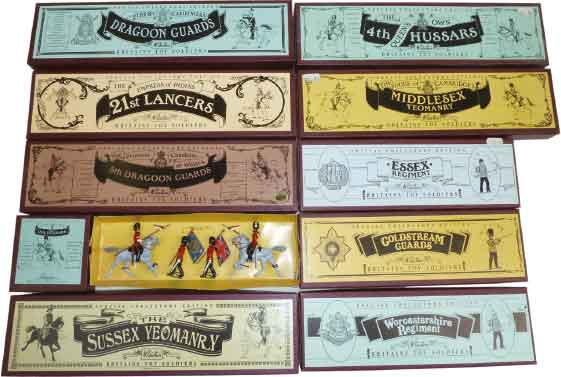
Picture 277: Box labels for the Britains Toy Soldiers series
These were very consistent, and gave the series an excellent identity. The three sizes of box, in descending order, contained four cavalry, six infantry and either two infantry or one cavalryman. In the middle is the insert card with soldiers from the Limited Edition 0032 of my The Great Book of Britains. It is the only set of mixed cavalry and infantry apart from the Dennis Britains set 8813, the only set to include both the queen’s and regimental colours and one of only two limited edition special items in the entire series. In a wonderful instance of history repeating itself, the Scots Greys were made at the factory with fusilier heads, in exactly the same way as the original Germanic Scots Greys had been made in 1893. B
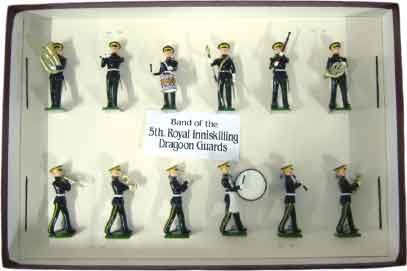
Picture 278: Britains copy dismounted Band of the 5th Dragoon Guards, No.1 dress
There were plenty of other people prepared to supply soldiers that looked as though Britains had made them. Britains themselves never got around to issuing sets of old style bandsmen, but here is someone (a small output private individual) who is very good at it. B
In 1995 a new marching infantryman was introduced, so infantry sets could be produced which normally included four at the slope, colour bearer and officer, but as both arms as well as the head were replaceable could also be used to produce infantry marching at the trail. Owing to the late arrival of some sets that had already been allocated catalogue numbers, the issues of the Indian Army in 1996 have earlier numbers than some of the later sets in 1995. All the D-Day commemorative figures except the beachmaster were re-issued in two figure sets for VE-Day, the beachmaster being replaced by a British military policeman directing traffic. Each two figure set contained a British figure with the United States equivalent, to celebrate the alliance in Britains two main markets. In this year an American Civil War series was added as a third theme to the British and Indian Army themes. The Pontoon Section, though not numbered in the series sequence, kept on with the desire to reproduce old Britains figures and introduced new team horses that were to reappear in the following year for the American Civil War.
8836 45th Rattray’s Sikhs, officer and colour bearer 1996
8837 45th Rattray’s Sikhs, two buglers 1996
8838 45th Rattray’s Sikhs, two at the trail 1996
8839 27th Madras Light Cavalry (single figure) 1996
8840 2nd Bombay Lancer (single figure) 1996
8850 Royal Scots Greys 4 pieces 1996
8851 ACW Confederate Infantry in action 6 pieces 1996
8852 ACW Union Infantry in action 6 pieces 1996
8853 ACW Confederate Cavalry 1996
8854 ACW Union Cavalry 1996
8855 Royal Marines 6 pieces marching at the slope 1996
8856 Princess Patricia’s Canadian Light Infantry marching at the slope 1996
8858 VE-Day Pilots 1995, 50th Anniversary set
8859 VE-Day Airborne Infantry 1995, 50th Anniversary set
8860 VE-Day Infantrymen 1995, 50th Anniversary set
8861 VE-Day Military Police 1995, 50th Anniversary set
8862 VE-Day Navy 1995, 50th Anniversary set
5962 Pontoon Section Royal Engineers 1995
1996
8841 2nd Gurkha Rifles at the trail (colours replaced by bugler) 1998
8842 27th Punjabis at the trail 1998
8843 Governor General’s Bodyguard, mounted 1998
8844 25th Cavalry, Frontier Force, mounted 1998
8863 Buffs officer and colour bearer 1998
8864 Devonshire Regt officer and colour bearer 1998
8865 Buffs two marching at the slope 1998
8866 Devonshire Regt two marching at the slope1998
8867 Northumberland Fusiliers marching at the slope 1998
8868 Royal Engineers marching at the slope 6 pieces 1998
8869 ACW Union Gun Team 10 pieces 1998
Picture 279: Indian Army Britains Toy Soldiers
Britains marching native Indian Army figure first issued in 1896 was the first ever movable arm Britains infantry model (see Pictures 31 and 83). The Indian Army of the British Empire has remained a favourite for Britains collectors ever since, so reviving the figure in diecast form made a lot of sense. Britains only ever made five each of Indian infantry and cavalry regiments in hollowcast, although there were also the Bikanir Camel Corps, the khaki figures of 1940 and collectors commissioning a large variety of special paintings around 1938. In the Britains Toy Soldier Range, there were ten cavalry regiments based on the new diecast horse similar to the old horse. In infantry, there were seven regiments. So for once the revived figures offer a great deal more variety than the originals, especially since extras included buglers, colours and European officers mounted and on foot, which had not been available for the old figures except as special commissions. In addition, in New Toy Soldier style from 1998 there were a further nine infantry and four cavalry regiments, the Bikanir Camel Corps and various ceremonial artillery and elephants. Here in the infantry column front to back are seen 8832 15th Ludhiana Sikhs, 8842 27th Punjab(Rawalpindi) Regiment 8833 127th Baluch Light Infantry and 8837 45th Rattray’s Sikhs, which was a small two figure set. For the cavalry, two sets 8835 Corps of Guides Cavalry lead 8839 27th Light Cavalry and 8840 2nd Bombay Cavalry, which are both single figure sets. B
8870 ACW Confederate Supply Wagon 7 pieces 1998
8873 ACW Union Supply Wagon 7 pieces 1998
8874 ACW Confederate Gun Team 10 pieces 1998
8875 ACW Union Gun and Crew 6 pieces1998
8876 ACW Confederate Gun and Crew 6 pieces 1998
1997
8845 1st Bombay Infantry 1997
8846 1st Central India Horse, mounted 1997
8847 Madras Sappers and Miners 1997
8877 ACW General Lee, mounted 1998
8878 ACW General Grant, mounted 1998
8879 ACW Confederate infantry officer and colour, 1998
8880 ACW Union infantry officer and colour, 1998
8881 ACW Confederate infantry marching at the slope, 1998
8882 ACW Union infantry marching at the slope, 1998
8883 ACW Confederate Williams gun and crew 1998
8884 ACW Union Gatling gun and crew 1998
The American Civil War was originally introduced to Britains hollowcast lists in 1951, and has remained a strong favourite ever since, included in the Herald, Eyes Right, Deetail, Toy Soldier, Hollowcast revival, New Toy Soldier and collector’s models. The original hollowcasts with the addition of the artillery, machine guns and supply wagons above form an ensemble particularly pleasing to Britains hollowcast collectors, even though the artillery sets and the generals are more akin to New Toy Soldiers than they are to hollowcast Britains.

Picture 280: American Civil War Artillery
In the foreground, Union sets 8869 and 8875, with two sets 8854 Union Cavalry behind, and opposite, Confederate set 8876 with 8870 Confederate Supply Wagon. Contrasting these sets with the old hollowcast figures (see pictures 192 and 192B) the colour of the paint has become brighter and more garish over the intervening forty-seven years. Note that the cavalry figures are almost identical to the hollowcast, as they use the same model of horse. B

Picture 280A: 8870 Confederate Supply Wagon
A close -up of the new supply wagon, an item not issued by Britains before in any ACW series. Behind is set 8876, the gun with crew. The crew are completely different to the old hollowcast figures, much more in the modern ‘New Toy Soldier’ style, by contrast to the cavalry and infantry in action where the hollowcast tradition is closely followed. This is just the time when the Britains Toy Soldiers range is starting to break away from the constraint of just being copies in diecast of the original hollowcasts. B
Picture 280B: Box labels for the Britains Toy Soldiers American Civil War series
In the tradition of the old hollowcasts from the golden age, individually illustrated boxes were provided for each set, although some drawings were modified to serve with both sides. Ironically, the original old hollowcast sets from 1951 had all appeared in generic ‘Regiments of All Nations ‘boxes illustrated with British uniforms in full dress! B
Other items that would fit in with this attractive cameo are the second grade hollowcast American Civil War figures from the 1950s, which included a charging figure, the 1954 Zouave Picture Pack 1362B and the Zouave set 40198 from the hollowcast range. This series from the Britains Toy Soldiers range was discontinued in 1998 to make way for the new model style range of American Civil War figures introduced in 1999 (see Chapter 7). Because of the popular theme and short issue life, it would not surprise me to find that these sets became some of the more strongly valued sets of the future. Further models have been issued in 2013 in the Archive Collection (see below).
8890 Oxfordshire and Buckinghamshire Light Infantry marching at the trail 1997
8891 London Rifle Brigade marching at the trail (colours replaced by bugler) 1997
8892 Norfolk Yeomanry, mounted 1997
8893 Sussex Yeomanry, mounted 1997
1998
In 1998, sets in the Britains Toy Soldier series other than the pioneering ACW sets started to be created in the New Toy Soldier style that was gradually taking over much of the new offering overall. Just seven more sets in the series were to be issued using the hollowcast lookalike figures produced so far, followed by six sets of cavalry in the Crimean War series.
8951 38th Central India Horse, mounted 1998
8952 5th Bombay Cavalry, mounted 1999
8953 9th Bengal Lancers (Hodson’s Horse), mounted 1998
8958 Lanarkshire Yeomanry, mounted 1998
8959 5th Royal Irish Lancers, mounted 1998
8960 Royal Dublin Fusiliers in action 1998
1999
00128 King’s Royal Rifle Corps, marching at the trail (colours replaced by bugler) 2000
The Crimean War series containing British Army cavalry based on the diecast ‘head up trotting horse’.
5197 Charge of the Light Brigade, one each of five regiments, with opposing Russians with Cannon (this was part of the Limited Edition series, see also above)
00169 Heavy Brigade
03109 8th Hussars
03110 11th Hussars
03111 4th Light Dragoons
03112 13th Light Dragoons
03113 17th Lancers
After 1999, no more additions were made to the diecast Britains Toy Soldier series. Starting in 1998 many more sets were made for or by Britains in the New Toy Soldier style to be added to the Britains Toy Soldier series. The ten-year run of diecast ‘hollowcasts’ was nevertheless impressive, with ninety-nine sets issued in or near the old toy soldier style. This compares interestingly with the first ten years of Britains original hollowcast production, when just one hundred and twenty- three sets were issued in the main series, though fewer were discontinued during the ten years, and many were updated with new versions (see Chapter 1)
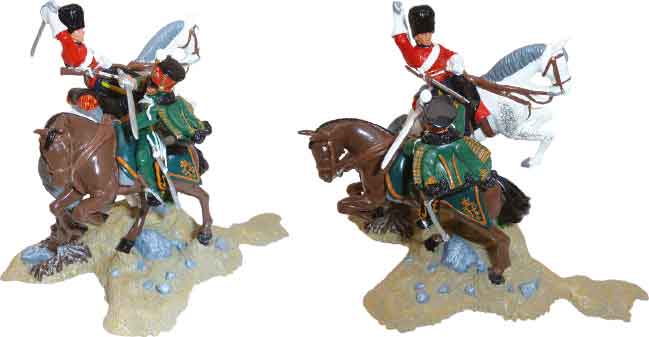
Picture 281 and 281A: set 00170 Crimean War vignette, Scots Grey vs. Russian 11th Hussar
It is difficult to find an angle that takes in all the beauty of this two figure combat scene from the Charge of the Heavy Brigade at Balaclava. The only answer is to possess one and turn it round in your hand. It is a style often used recently by the better New Toy Soldier makers, and comes closer to a military miniature than to a toy soldier, without going the whole way towards an ultra-realistic model. B
Picture 282: Crimea vignettes 1999
Set 00263 Butcher Jack chasing a Russian infantryman, is on the left, and set 00171 with a 17th Lancer duelling a Russian artilleryman in the centre. On the right is the distinctive Scots Grey from the Heavy Brigade set 00169. Compare this picture, particularly the central vignette, with picture 311 in the Crimean VC series below to see how far or not the Britains Gloss series modelling had progressed from 1999 to 2006. B
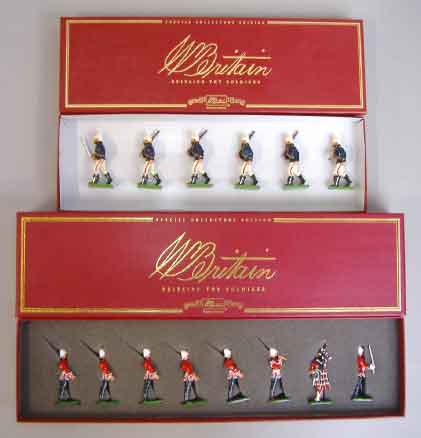
Picture 283: Britains Toy Solder Series in ‘New Toy Soldier’ style
These sets are shown with the new style generic red boxes that came in with the change of ownership to Racing Champions. Presumably there was a saving associated with no longer having individual boxes, but it was also fitting that at the time that the old style diecast figures stopped the box style stopped with them. The cut-off is not exact, with some old style figures being issued in new style boxes. The sets here are top: an unusual set that had no end label on the box, and I was unable to find in any catalogue or literature. I asked John Waterworth, co-author of Britains New Toy Soldiers, what he thought of them, and he provided the answer as follows: “The officer is the identical officer from the centenary set issued in 1997 No.8898 Royal Navy Field Gun Landing Party and the infantry are identical figures with substituted rifle arm at slope for the sword arm. These boxes of different figures of odds keep cropping up at times in official boxes with no set numbers on the boxes; boxes and figures always appear to be from surplus unused stock items.” The clue was the sword scabbards still present on all the figures. Bottom: regular 00216 Royal Scots in foreign service helmets issued in 1999. B
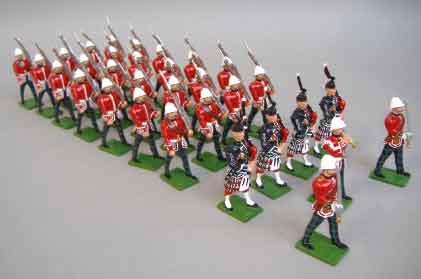
Picture 284: The Royal Scots of set 00216 on parade
Who would want to own a single set of these when four sets are so much more fun. That man in the nearest file is fouling up the parade – get straightened up!! B
Picture 285: set 00131, Durham Light Infantry 1890
New Toy Soldier style, spincast rather than diecast, which allowed more detailed figures in more different poses to be cast in shorter runs and still be economic. For much longer runs, the production runs of diecast figures became the more economical. B
Some series later in the life of Britains Toy Soldiers contain mixtures of style. The Crimean War Series, for instance, is a rather messy amalgam of Limited Edition, old style cavalry and new style infantry, artillery and vignettes. The American Civil War was also mixed, though the sets not following faithfully to originals were not so obviously out of place. The other series coming within (and sometimes breaking out of) the main series heading was the Indian Army, which eventually got attached to the new Delhi Durbar series (see below).
The only character figures in the entire Britains Toy Soldier series were spincast as follows:
8877 ACW General Lee, mounted 1998
8878 ACW General Grant, mounted 1998
00263 Butcher Jack, Charge of the Light Brigade
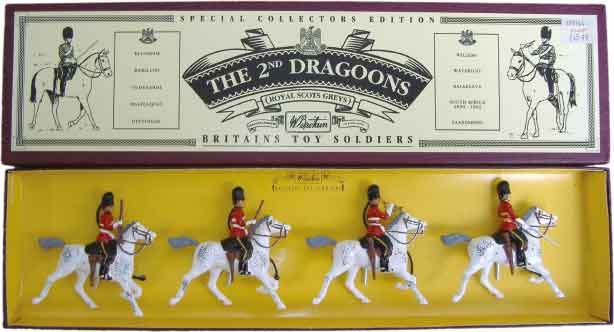
Picture 286 and 286A: Royal Scots Greys
When the Greys were issued as set 8850 of Britains Toy Soldiers in 1995, they had acquired proper bearskin caps rather than the fusilier caps of my pair of lancers (see picture 277). In 1999 they were issued again in set 00075, at the halt and with dismounted sentry and sentry box, in the New Toy Soldier style. B
Past Editions 2000
A few surplus castings from the Britains Toy Soldiers range were painted up and included as single figures in this clear-out attempt.
Hollow Cast 2001-2004
This was an ambitious attempt to revive Britains hollowcast figures from original moulds, advised by Peter Cowan, who was at the time working for the Britains Collector’s Club. Just eighteen sets were produced, ten of them in the first year. Production difficulties, their high price and relatively low demand all contributed to a shortfall in the success of the series, stopped after only three years.
At the time that the series was first mooted, collectors were somewhat worried that the announced intention of reproducing the paint style of Britains special paint from the late 1930s would cause confusion on resale, but when the finished product was revealed, these fears were proved groundless as they were easily distinguishable. The original hollowcast set numbers in which the figures appeared are given in brackets, with any changes made from the original figures.
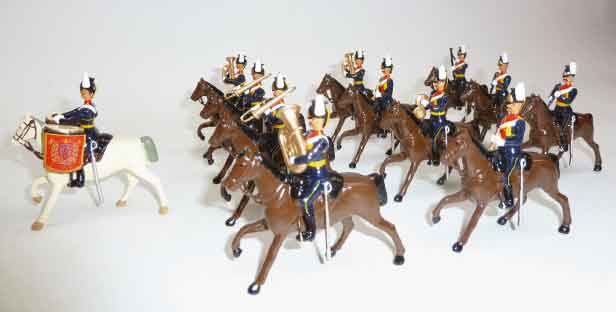
Picture 287: set 40191, Mounted Band of the 9th Lancers
Another mounted band to add to the old sets 101 and 1721 was possibly the most welcome of all the Hollow Cast projects to collectors, who had been feverishly converting rather scarce Royal Scots Greys for decades. The new mounted bandsmen tended to have rather elongated necks, but were otherwise very acceptable. B
Picture 288: sets 40192 and 40193 Fort Henry Guard
This was a brand new marching figure made by putting the Fort Henry head on the full trouser box pack body, as used for the fifth version of the Royal Welch Fusiliers. This is actually more a 52mm scale figure than 54mm, and so seems rather shorter when not surmounted by a fusilier cap. The Fort Henry Guard was also given a small looking loose sling rifle without bayonet from as early as 1897, and the overall effect is a not unpleasing small but neat figure. In the goat and mascot set, the handler (another figure not provided before by Britains in a hollowcast style range) is simply the same as the rifleman but with an empty hand, and the goat, somewhat strangely, is a reproduction of the Royal Welch Fusilier mascot rather than the perfectly good different goat provided in 1957 for the original Fort Henry set 2148. All these new Fort Henry figures feel more solid cast than hollowcast, and one of the major problems with the Hollow Cast range was that by and large they were not really hollowcast at all. Aside from that, the new figures were painted neatly enough, with the lining and crossbelts being extremely good. As opposed to the old figures to the left and the Royal Welch Fusiliers to the right, this stands out in contrast extremely well. The new Fort Henry figures also did not have any red in the plume, which in the original figures had been white over red rather than just white. Whether because a large anticipated order from Fort Henry failed to materialise, or because they just did not sell all that well when original Fort Henry figures were by and large less expensive to obtain than the new ones, there has been a substantial surplus of these figures left over when they were discontinued. At the time of writing it is possible to obtain at the shows eight figures for £10 from Lynn Kenwood, which is one of the all time toy soldier bargains ever offered. B
40189 Cameron Highlanders colour party 2001-2004 (set 2111 in different regiment)
40190 Cameron Highlanders marching with officer 2001-2004 (sets 112 and 437 in different regiment)
40191 Mounted Band 9th Lancers 2001-2004 (set 1721 with new head, different regiment)
40192 Fort Henry Guard marching at the slope 2001-2004 (new figure)
40193 Fort Henry Guard mascot goat and handler 2001-2004 (set 74 and new figure as 40192)
40194 1815 British Infantry 44th Foot 2001-2004 (set 1518, second version, new regiment)
40195 1815 Highland Infantry 79th Foot 2001-2004 (set 1519, second version, new regiment)
40196 17th Lancer Officer, rearing horse 2001-2004 (set 1, third version, new regiment)
40197 H.M. the Queen 2001-2004 (set 2065, different colour horse)
40198 ACW New York Zouaves 2001-2004 (set 1362B)
40199 2nd Dragoon Guard Officer 2002-2004 (set 39 with new head, different regiment)
40200 Royal Scots Grey in cloak 2002-2004 (set 400 with new head, different regiment)
40249 Royal Fusiliers colour party 2002-2004 (set 2084 with new head, different regiment)
40250 Royal Fusiliers marching at the slope 2002-2004 (set 1515 with new head, different regiment)
41001 Cameron Highlanders Pipe Band set 1 2003 only (sets 2109 different regiment and 2025)
41002 Cameron Highlanders Pipe Band set 2 2003 only (sets 2109 different regiment and 2025)
41003 Cameron Highlanders Pipe Band set 3 2003 only (sets 2109 different regiment and 2025)
41004 Cameron Highlanders Pipe Band set 4 2003 only (sets 2109 different regiment and 2025)
The last four sets were supposed to make up into a complete pipe band, but there seem to have been problems with this, see Collecting Toy Soldiers in the 21st Century, page 118.
Archive Collection 2007-present
Yet another attempt to revive figures that would fit in with old hollowcasts. These ones mostly reproduced old figures fairly faithfully with the occasional interesting add-on. They have been presented either as singles or in sets of four figures. The models are short run spincasts, However, at a minimum of £12 for each figure they are generally more expensive than the old original hollowcast figures they are meant to add on to. Numbers with a C suffix are William Britain Collector’s Club exclusives, which is how the earliest sets made their appearance in 2007.
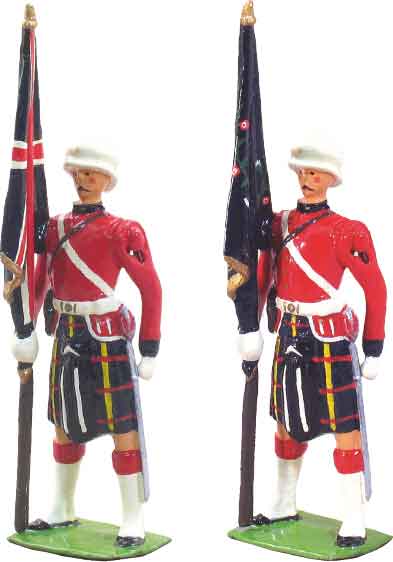
Pictures 289 and 289A: Cameron Ensigns
These were perhaps the most ingenious of the new old style figures, using the standing highland officer with binoculars, removing the binoculars and replacing them with arms as a colour bearer. Painting them as Cameron Highlanders fitted them in with the old set 2025 as a really useful add-on. They are the only ones of this Archive Collection that I really wish I had had the courage to purchase when they came out. 289 is 49006 King’s Colour and 289A is 49009 Regimental Colour. W
43117C Coldstream Guards marching with officer 2007 (set 93 third version, different regiment)
50000C Coldstream Guards command set 2007 (set 82 third version, different arms)
50001C Coldstream Guards marching 2008 (set 93 third version, different regiment)
49000 Cameron Highlanders firing 2008 (set 2025)
49001 2nd Bombay Native Infantry 2008 (set 68, second version)
49002 Cameron Highlanders marching 2009 (set 114, fourth version, fixed bayonets, new officer)
49003 Gurkhas marching at the trail 2009 (set 197, sergeant with empty hand)
49004 Gordon Highlanders marching at the slope 2009 (sets 77 third version and 437)
49005 Cameron Highlander standing firing 2009 (set 2025)
49006 Cameron Highlander Queen’s Colour 2009 (set 2025 officer with two new arms)
49007 Irish Guard marching at the slope 2009 (set 107, third version)
49008 Irish Guard officer 2009 (set 107, third version)
49009 Cameron Highlander Regimental Colour 2009 (set 2025 officer with two new arms)
50007 Life Guard sentry on foot 2009 (set 2029)
49010 Fusiliers marching at the slope 2010 (set 7, fourth version)
50017C Fusilier officer marching 2010 (set 7, fourth version)
50019C Fusilier pioneer marching 2010 (set 73)
49011 7th Hussars dismounted with officer and trumpeter 2012 (set 182, new arm and uniforms with red busby bag rather than the white one incorrectly shown in Winter 2012 catalogue, where the photo of the 13th Hussars was duplicated)
49012 11th Hussar officer dismounted with sword 2011 (set 182 third version) As in the original set 182, this figure has the same head as the three troopers. In 182, the frogging and facings were yellow in the figure with the sword, implying that it was meant to represent a sergeant. Here, the figure has been given gold frogging and facings, with white gloves, but not the tall officer’s plume
49013 11th Hussar trooper dismounted 2011 (set 182 third version)
50027C 11th Hussar trumpeter dismounted 2011 (set 182, new arm)
49014 Royal Marine Light Infantry officer 2011 (set 1620, new arm)
49015 Royal Marine Light Infantry bugler 2011 (set 2115, new uniform)
49016 Royal Marine Light Infantry marching at the slope 2011 (set 1620)
49017 RCMP dismounted, trumpeter and at ease (Picture Pack 1374B with two new arms)
49018 RCMP at ease (Picture Pack 1374B with new arm)
49019 7th Hussar dismounted (set 182, new uniform)
49020 13th Hussars dismounted with officer and trumpeter 2012 (set 182, new arm and uniforms)
49021 13th Hussar dismounted (set 182, new uniform)
49025 ACW Confederate Infantry 2013 (set 2060) This came with two new combinations of figure and hat, and instead of the standing gaitered figure used in 2060 and 2059 back in 1951, a full trouser figure was used, as in the Britains Toy Soldier ACW sets
49027 ACW Union Infantry set 1 2013 (set 2059 and set 8852)
49029 ACW Union Officer 2013 (Picture Pack 1249B)
49030 ACW Confederate Officer 2013 (Picture Pack 1237B)
49032 Germanic Life Guard Officer (set 1, first version)
49033 Germanic Life Guard (set 1, first version)
Picture 290: Archive Fusiliers marching
By contrast with the Cameron Ensigns, there seems to have been no particularly good reason fro bringing out these fusiliers, which are simply a fairly faithful copy of the Royal Fusiliers original set 7, circa 1937. The rifles are a little different, but this is not going to make collectors want to buy them at £50 when they can get a good original boxed set of seven with an officer for about £150. Very similar Royal Welch Fusiliers retail for under ten pounds a figure second hand. W
Heritage Collection 2009-2012
This was a revival of the ever-popular Hunting Series as spincast figures. It included two mounted ‘Full Cry’ huntspeople, with fox and hounds, and the two standing figures from ‘The Meet’. Five small sets and one combined set were offered. The resale value of the original hollowcast hunting series figures has remained much higher comparatively than for soldiers or most other civilian figures, so an accurate archive revival was a good bet. However, no additional sets have been offered during their four year spell in the stock catalogues, so it may be that sales were not as good as expected. There was no attempt to produce any figures not in the original series.
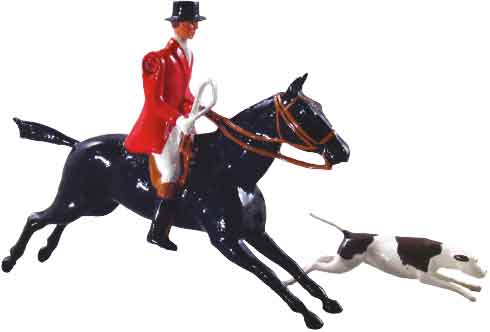
Picture 291: 49500 Huntsman mounted with hound
It can be seen from this Britains catalogue picture that the original style from the ‘Full Cry’ set has been followed as faithfully as possible, although the paint is even glossier than in the 1960s. W
Products produced in New Toy Soldier styles
Britains, after starting for collectors with straightforward revivals and extensions, branched out into new ideas. It was rapidly becoming obvious that as far as anything to do with collectors was concerned, the cost of producing short run spincastings in China was far lower than anything that could be done in the UK just by converting diecastings. The diecast figures for the tourist trade were in any event now also made and painted in China. From this point on, therefore, it can be taken as read that manufacturing was sourced in China with ideas and designs carried out in the UK or the USA. Some of the figures produced still used diecasting, others were wholly or partly spincast. It depended on the costing as to which route was followed, but as the product became more diverse and the runs shorter, the spincast route tended to become more attractive.
There are therefore quite large parts of the Ceremonial (ex Metal Models), Britains Toy Soldiers, Limited Edition and Collectors Club ranges that from the stylistic and production point of view should be included under the New Toy Soldier style heading, but because they are continuations of previous series have already been dealt with above. In the Limited Editions range in particular, a wide range of styles was used from 1997.
Home Farm 1995-1998

Picture 292: Home Farm sets in original boxes
Left to right, set 8712 Blacksmith, set 8707 Tumbrel Cart (compare to 4F in picture 186) and 8706 The Forge. Britains had not made a forge in their original hollowcast series, though several competitors had. From this period on, deep cut out foam packing featured widely as mail order was now the norm for delivery. B
This attempt at a revival of the hollowcast style Home Farm included four sets brought out in 1995 and six sets issued in 1996. In view of the vast amounts of the old hollowcast figures readily available, most collectors were loath to part with quite large sums of money for items that had been issued by Britains or others before. The items in this series were all solidcast rather than diecast.
Centenary Series 1995-2000
Apart from the sets issued in 1993 to mark the centenary of Britains, the Britains team approved an idea to take an iconic set of 100 years before, and recreate it as a Centenary celebration of that occasion. These sets, from 1995 to 1997, were made in the New Toy Soldier style, and to start with outsourced to HM of GB, whose quality product had impressed Britains. They were also one of the few new toy soldier makers apart from Britains to use diecasting. The series was relatively short lived, the subjects being:
8857 RA Mountain Battery, originally set 28 issued 1895
8872 Camel Corps of the Egyptian Army, originally set 48 issued 1896
8898 RN Landing Party with Gun, originally set issued 1897
These three sets were direct re-issues in a new style of the original Britains sets. From 1998 to 2000, the connection to the original sets was a little less direct.
8899 Spanish-American War, originally marked by Britains with sets 91 and 92, 1898
00073 and 00074 Mounted Band of the Life Guards at the halt, originally set 101, 1899
00261 City Imperial Volunteers, originally set 104, 1900
The Centenary Series contained one character figure of Theodore ‘Teddy’ Roosevelt in set 8899.

Picture 293: set 8872, Egyptian Camel Corps
Only four figures in this set, compared with six in the original set 48. Although nothing like the first figures, these camels and riders were very creditable additions to the list. This series was the first to be made entirely in New Toy Soldier style. B
Picture 294: set 00261 City Imperial Volunteers
These men were taking their lives in their hands charging forward in this fashion against a Boer position, especially the officer brandishing a sword and pistol, which would mark him out for Boer target practice. Mind you, the original CIVs of set 104 one hundred years before were just as exposed, also with an officer with sword and pistol, though he had not yet enthused them to charge (see picture 52). B
Premier Series 1995-1998 and 2003-2005, and World War I 1998-2001
The talented pair of designers who made their main careers at Britains, Roy Selwyn-Smith and Charlie Biggs, had worked for others before they came to Britains. When Britains moved to Nottingham, Charlie Biggs, who had retired in 1989 but continued to consult for Britains, did not move with them, and decided to start designing a new toy soldier range in his favourite period, the First World War. This was going to be an independent venture with Arnold Rolak, an influential Britains enthusiast, under the name Sceptre. However when Britains heard about it, in a move remarkably similar to when they acquired Selwyn-Smith’s Knights in 1954, they offered to buy and distribute the range under their own brand as the Premier range.
The arrangement lasted on and off for seven years, with a hiccup in the middle when Britains presented a World War I section in the catalogue without it being under the Premier name. This may have been caused by difficulties in finalising the contractual terms for the period. The items presented as Britains not in the Premier series are remarkably similar in style to those that are, so that for all practical purposes they should be taken together as a whole.
The series originally majored heavily on artillery and vehicles with accompanying personnel rather than straightforward sets of soldiers. Until 1998 it was marketed in black boxes with Charles Biggs acknowledged as the creator of the series, the first such acknowledgement on packaging in the history of Britains. After the re-introduction in 2003, the acknowledgment was no longer present. Following the end of the contract in 2005, further Premier products were produced by Charles Biggs outside the Britains distributed range.
Many of the guns came out with crews in different dress, and in among the WWI action and uniforms there are a number of sets in 1914 full dress. During the period that it was not running under the Premier label, acknowledgement was made to the two major innovations of the First World War with the production in 1998 of both a Mark 1 tank and a Sopwith Camel, followed in 1999 with the Red Baron’s Fokker Triplane.
The Premier Series has held its value better than almost any other Britains made for collectors, and ranks alongside Tradition, Blenheim and Trophy as in the top rank of New Toy Soldier collectables not specifically designed to fit with the old hollowcast Britains. Together with competitive series from such makers as Tommy Atkins and the Toy Army Workshop they form a distinct group of products that has had good success in the market. Charles Biggs deserves much credit for this venture, and remained active amongst collectors, selling various mementos of his career at Britains from time to time, and appearing at various dinners and other occasions. He died on 9th March 2013 at the age of eighty after sixty years of making toy soldiers.

Picture 295: Premier Series sets 8919 and 8935
8919 is a British 13pdr QF gun in action around 1916 with limber and crew, the type of gun used by the Royal Horse Artillery. Set 8935 features the notorious Manfred von Richthofen, a.k.a. The Red Baron. B

Picture 295A: Premier Doctor and Nurses
Looking at these figures from set 41033 shows that Charles Biggs believed in simple but striking design, still very true to the appearance of old fashioned toys. B
Picture 295B: Competition for the Premier series
A glossy wiring party sets out, covered by matt finish riflemen lining the parapet. This mixed collection in the trenches shows the varied competition faced by the Premier series. The First World War is such a vast subject that no-one can possibly cover it all, and there are opportunities for everyone, especially with the centenary approaching. Britains has now pinned its hopes on a Matte series (see Chapter 7). B
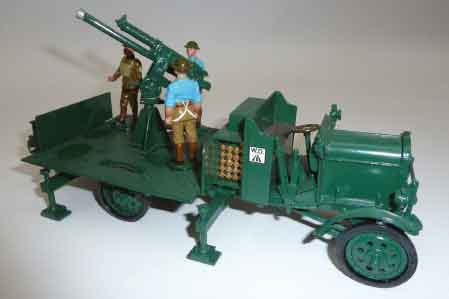
Picture 295C: Premier set 8926, Thornycroft AA truck
This was state of the art gear in the First World War, when motor vehicles were relatively sparse and the threat from above relatively new. Countermeasures to aircraft had to be devised in a hurry! One of the crew members in this set is missing from this photograph, but it is my favourite Premier set. B
Picture 296: WWI Tank
Britains were very proud of this model, which featured beneath a Sopwith Camel on the cover of the 1998 catalogue. The figures, in the Premier style, came with it in set 08946. B
VC Series character figures:
8928 Captain Albert Ball VC, Royal Flying Corps 1997
8929 John Travers Cornwell VC, Royal Navy 1997
8930 Captain Harold Ackroyd VC, Royal Army Medical Corps 1997
8931 Sergeant George Harry Mullin VC, Princess Patricia’s Canadian Light Infantry 1997
WWI Air Ace Series:
8932 Captain Edward Vernon Rickenbacker, 94th US Aero Squandron 1997
8933 Flight Commander Charles Rumney Samson, Royal Naval Air Service 1997
8934 Lieutenant Jean Navarre, French Military Aviation 1997
8935 Captain Manfred von Richthofen ‘The Red Baron”
Other Characters:
00158 Manfred von Richthofen with Lothair and Triplane 1999
00158 Lothair with Manfred von Richthofen and Triplane 1999
41038 H.M. King George V mounted, full dress 2003
41106 General John J. Pershing with Douglas MacArthur and Colonel Nimon 2004
41106 Brigadier General (acting) Douglas MacArthur with General Pershing and Colonel Nimon 2004 41106 Colonel Nimon with Douglas MacArthur and General Pershing 2004
41149 King George V in France with Earl Kitchener 2005
41149 Earl Kitchener in France with King George V 2005
Competitors to Britains New Toy Soldier style products
Britains came into the collector market via two distinct series, both diecast. These were the Metal Models primarily aimed at the tourist trade, and the Britains Toy Soldier range aimed at collectors of the old hollowcast Britains toys. Until 1995 Britains had not issued anything that was not allied to one of these two series, and so had preserved a product differential from all but the most flagrant purveyors of Britains lookalikes. Thereafter, as mentioned above, the Britains Toy Soldier series and various other new series branched out into uncharted waters in direct, indistinguishable competition with the rest of the market, to sink or swim on their own merit with only the Britains trademark to help them on their way.
Picture 297: All the Queen’s Men
Derek Cross has been making these 51mm scale figures since 1981, and they are very attractive. Here a column is on its way to South Africa for the Boer War, and one man, closely watched by sergeant and officer, is waving goodbye to his girl, who is out of shot. The scene is entitled ‘Goodbye Dolly Gray’. B
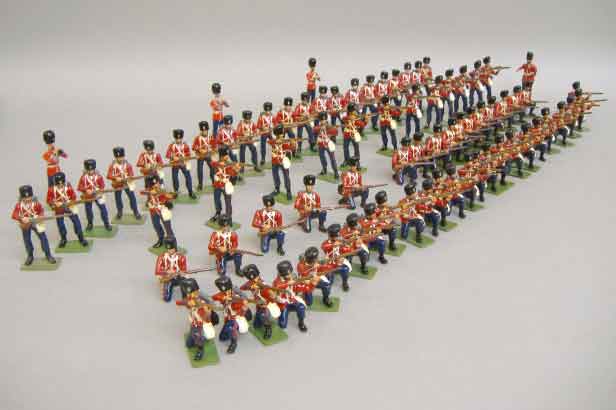
Picture 298: HM of Great Britain Fusiliers
This company used diecasting as well as solidcasting, and because of their potential to produce large volumes quickly made a number of sets for Britains, notably the Centenary series sets 8857 Mountain Artillery and 8872 Camel Corps. Here we see a company of Fusiliers firing, an array as good as anything Britains was capable of in the New Toy Soldier style at this date (1995). B
Picture298A: from set 8813, 7th Royal Fusiliers in action
In the old days, Britains had never made Fusiliers in action, so the firing positions here are completely new to the hollowcast style. The on guard part of the sets is probably off guarding the flank against cavalry. Although these look good in the context of hollowcast style figures, the completely different appearance of the similarly posed figures by HM in picture 298 may be more to some people’s taste. Between these, the New Toy Soldier style figures to come and the models of the Seventh Age, Britains were about to cover the whole collector market. See picture 276A. B
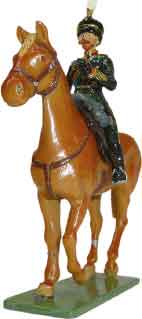
Picture 299: HM of Great Britain Duke of York
Another outstanding model from HM is this portrait figure of the Duke of York (later King George VI) as Colonel of the Sussex Yeomanry. B
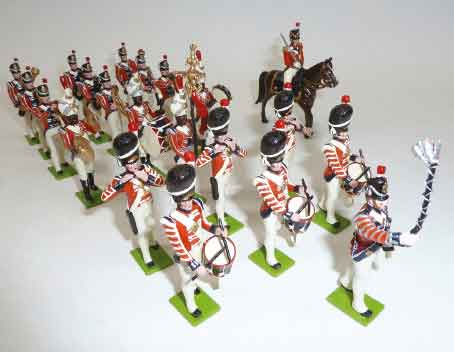
Picture 300: Tradition Band of the Coldstream Guards 1815
In some ways Tradition were the ones to beat when Britains stepped up to the mark in New Toy Soldiers. Tradition had offered a consistently excellent product in New Toy Soldiers from 1980. If someone were to straighten the mace of the Drum Major which has got slightly bent, there would be very little to complain about in this glorious group of figures. B
Picture 301: Under Two Flags Egyptian Cavalry
These amazing cavalry models issued by the well known London toy soldier shop Under Two Flags are probably actually produced by Trophy. With competition this good, would Britains survive? B
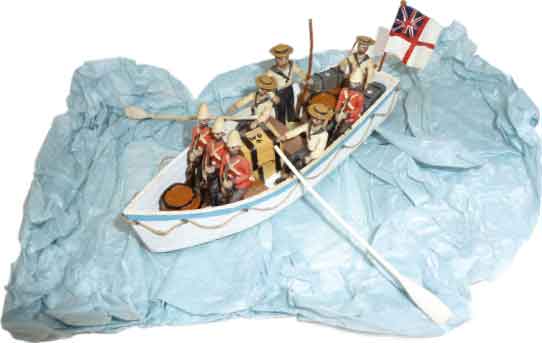
Picture 302: Under Two Flags disembarkation at Alexandria
Under Two Flags used to commission interesting set pieces as exclusives from various New Toy Soldier manufacturers. One I am particularly fond of is this rowboat with soldiers landing in Egypt. B
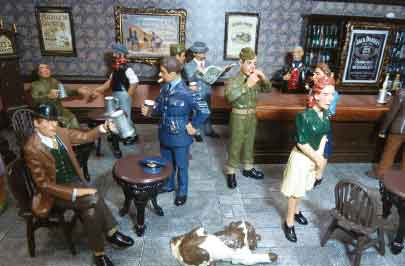
Picture 303: Marlborough WWII Pub
This superb gloss diorama in new toy soldier style evokes all the atmosphere of the fighter station local even though the figures are by no means realistic to military model standards. B
Picture 304: Size matters
The original but heavily repainted Britains hollowcast foot guard on the left is a true 54mm scale figure. The tendency for New Toy Soldier manufacturers was to creep slightly larger, as in the central Ducal figure. Any larger, and figures would look incongruously tall, so Britains tried to avoid the heights of the figure on the right. B
Large numbers of excellent ‘New’ toy soldier makers had been in the market since the mid-1970s, the names most prominent being Blenheim, Mark Time, Trophy, Tradition, Asset, Ducal, Imperial Productions and William Hocker. It is worth looking at a few photographs (above, pages 284-286) of this very diverse competition to see what Britains were now up against.
The 1903 Delhi Durbar 1997-2004
Britains may well have observed that some new toy soldier manufacturers, notably Marlborough, had made a great success of a Delhi Durbar range. Indian Army figures featured in the Toy Soldier range from 1994, but from 1997 to 2004, thirty- two sets specifically to do with the Durbar were issued. These also seem to have proved popular, as very few of them have re-appeared on the market, and generally command good prices when they do.

Picture 305: State Elephants
Just because Britains hadn’t got there first did not mean they were no good when they did arrive, as was proved in the Delhi Durbar series, and especially in the elephants. Left to right: 40184 Maharajah of Bikanir, 8848 Lord and Lady Curzon, 08956 Duke and Duchess of Connaught with 08957 Ceremonial Elephant Guard and 40186 Nizam of Hyderabad. These magnificently caparisoned animals have kept or even increased their values. B
8848 Lord Curzon on state elephant with Lady Curzon 1997
8848 Lady Curzon on state elephant with Lord Curzon 1997
08956 Duke of Connaught on state elephant with Duchess of Connaught 1998
08956 Duchess of Connaught on state elephant with Duke of Connaught 1998
00264 Lord Curzon seated with Lady Curzon 2000
00264 Lady Curzon seated with Lord Curzon 2000
40184 Maharajah of Bikanir on state elephant 2001
40186 Nizam of Hyderabad on state elephant 2001
40164 Major A.G.Maxwell, Durbar Royal Herald 2002
40167 Maharajah of Patalia with escort 2003
Circus 1997-2000
The original hollowcast circus range (1936-1941 and 1951-1959) was 18 items. The new toy soldier style range was 25 items, and had a rather wider scope, including a backdrop for the ring and a street scene. The latter might come in handy for other occasions than the Circus Parade. The modelling of the new circus figures was excellent, and could well have appealed to children

Picture 306: Circus figures
The new Britains Circus people were much more animated than the hollowcast ones, and they all looked so happy. There was more than a touch of glamour to the shapely bareback riders. B
Tournament Knights 1998-2001, Knights of Agincourt 2002-2006 and Knights 2004-2012
At the start, the diecast figures of the Tournament Knights seemed likely to appeal to children as the series included a tiltyard and backdrop, and seemed made to be toys rather than collectors pieces, being un-named. The figures were made so that they could be given different heads, and the single mounted figure had a variety of arms and weapons. They would not have appeared out of place in the 5th Age, but from 2001, the knights were named after specific individuals and given historically correct heraldry. In 2002, the series was renamed Knights of Agincourt, and the first spincast figures were added. This new spincast range lasted until the end of 2006, when they were discontinued and replaced by a Matte range (see Chapter 7).
In 2004, the diecast range was split out into blister packs under the straightforward title ‘Knights’ and the range continued until 2007. A new range of named knights from the same diecast moulds was issued in 2008, appearing for five years before the series petered out. Although some of the individual spincast pieces had been good (I liked the archers, especially the mounted one), the lack of variety in the diecast mounted figures left them at a disadvantage against the several Courtenay and New Toy Soldier style series already very well established by 1998.
Character figures (diecast):
08410 Sir Thomas Erpingham (later 41079) 2001
08411 Compte de Fauqumbergues (later 41080) 2001
08412 Jaques de Crequy (later 41081) 2001
08413 Sir William Phillip (later 41082) 2001
08414 Sir Gilbert Umfraville (later 41083) 2001
08415 Guilliame de Courcy (later 41084) 2001
08416 The Earl of Huntingdon mounted (later 41089) 2001
08417 Comte de Beaufort mounted (later 41090) 2001
08418 The Earl of Oxford mounted (later 41091) 2001
40224 The Earl of Warwick (Warwick Castle special) 2001
40232 Guilliame de Martel, French standard bearer, mounted (later 41092) 2002
40233 Sir John Codrington, English standard bearer, mounted (later 41093) 2002
48700 The Earl of Warwick 2008
48701 King Henry V 2008
48702 Robert the Bruce 2008
48703 Sir Roger de Trumpington mounted 2008
48704 The Prince of Wales 2008
48705 Sir John d’Abernoun 2008
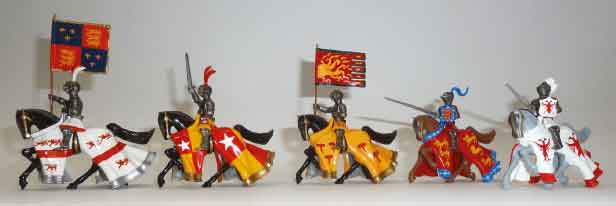
Picture 307: some Tournament Knights as renamed Knights of Agincourt in 2002
Very toylike figures, but in their way quite splendid. Left to right: 40233 English standard bearer Sir John Codrington, 08418 Earl of Oxford, 40232 French standard bearer Guilliame de Martell, 08416 Earl of Huntingdon and 08417 Comte de Beaufort. There was a change of direction in 2002 under the Knights of Agincourt label towards issuing something more realistic in the series of gloss finish knights, if only by giving them historical names. Although in 2006 some new Knights of Agincourt figures were created in matte finish, this experimentation was discontinued at the end of 2007. From the residue of the original diecastings were sold in gloss under new character names for a further five years. B
40234 King Henry V mounted (later 41094) 2002
40239 Compte de Vaudemont (duelling pair) 2002
40239 Sir John Grey (duelling pair) 2002
40240 Duc de Bourbon (mounted duelling pair) 2002
40240 The Earl of Suffolk (mounted duelling pair) 2002
40394 Sir John Falstaffe mounted 2003
40395 Robert, Comte de Marle mounted 2003
41097 Thomas Strickland with banner of St George 2004
41098 Sir Rowland Leinthall (with Robert d’Estoutville) 2004
41098 Robert d’Estoutville (with Sir Rowland Leinthall) 2004
41128 Guilliame de Tancarville mounted 2004
41141 Guilliame Martel, Sire de Bacqueville, with Oriflamme 2005
43003 Count de Fauquembegues mounted 2006
43017 Jean le Maingre, Boucicault, Marshal of France, with English Longbowman 2006
Rorkes Drift and Zulu War 1998-2009
As Rorkes Drift was the most famous and heroic event in British military history, it seemed a natural for a series. Starting with an ambitious (in price as well) Rorkes Drift diorama set nominally part of the Limited Edition series as number 5198, a limited edition hospital diorama was added in 1999. Further additions were made in every year until 2004, after which there was a hiatus until a final burst of sixteen new models in 2007 and 2009.
The 2008 catalogue stated ‘In keeping with the style of the popular Redcoats range, this new Zulu War gloss series is reminiscent in size, look and feel to the original W.Britain toy soldiers of the early 20th century.’ I’m afraid this was not true for me, much though the models were at the better end of New Toy Soldiers. The catalogue also promised more poses, cavalry and artillery, but the implementation did not live up to the plan, and the only four additional poses to materialise came in 2009, leaving collectors without cavalry or artillery. These did finally materialise in the artillery of the Matte Zulu War (which started in 2007) and the 17th Lancers in the Redcoat series, but were not very compatible with this series. The 17th lancers of set 8806, modelled after the original hollowcast set 81 were in ‘Ulundi’ service dress and could well be used with these, as could a number of the competing products.
Character figures:
5198 Lt. Bromhead with Limited Edition Diorama 1998
5198 Colour Sergeant Bourne with Limited Edition Diorama 1998
00144 Commissary Dalton with Chaplain Smith and two others 1999
00144 Reverend George Smith with Commissary Dalton and two others 1999
40175 Lt. Colonel Durnford, three men and wagon 2002
43156 Colour Sergeant Bourne and another man (Modelzone Exclusive) 2007
Trooping the Colour 2001-2005
Many collectors have been attracted to the idea of staging the Trooping the Colour ceremony, otherwise known as the Queen’s Birthday Parade. During 2001 Britains started a series intended to build up to the present day ceremony. Central to the series was the Ivory Phaeton, the royal carriage in which Queen Elizabeth II travelled to and from the ceremony since she no longer felt comfortable riding.
The series has similarities to the Club exclusive Queen Victoria series, but seemed to have little momentum, only extending to fourteen sets. To depict the ceremony, you need the Household Cavalry with the mounted band, the massed bands of the Foot Guards, and a large number of straightforward Foot Guards, marching, and/or in drill positions. This series took the form of a number of key individual figures or groups, possibly with the idea of placing them within collections already possessing enough ordinary troops to make the trooping. A good view of such a collection can be gained from picture 2.
To make this idea work for collections in the hollowcast style, it would be crucial that the additional figures were close enough in style to fit in. While the individual figures were pleasant enough, being in a rather individual New Toy Soldier style, they did not even fit very well with the Metal Models. Fitting in only with themselves, there were not enough of them to make a display work, and expecting collectors to buy enough of them proved to be illusory. On the plus side, there was a notable mounted figure of Princess Anne, as well as seated and standing models of the Queen.
Special figures in gloss
Royal Armouries and Palaces 2002-2006
In supplying souvenir style figures to the Royal Armouries and also including them in the catalogue, Britains were repeating their association with the Tower of London from 1933 to 1966 with the 16th Century Knights of set 1307. In the interim, the Tower had commissioned some very nicely made plastic models by John Niblett. This time round they remained in the catalogue for just three years.
The new range included seven personalised suits of armour from the Royal Armouries collection, looking rather stilted, just as they are on show. However, there was also one piece of the 1525 battle of Pavia (40921) showing the armour in action, as in the Armouries life size diorama, with three knights attacking four infantry.
Character figures (actually just looking like suits of armour, but we can pretend there are historic occupants):
40285 Henry VIII 1540
40286 Henry VIII mounted 1515
40287 Charles Stuart 1614
40288 Henry, Prince of Wales 1609 (with brother Charles)
40288 Charles Stuart 1615 (With elder brother Henry)
40289 Henri II of France, The Lion Armour 1550
40290 James II 1686
In another similar souvenir initiative, Britains supplied the Historic Royal Palaces gift shops with figures of Henry VIII, his six wives and Queen Elizabeth I. The two monarchs were very similar to those supplied to Madame Tussaud’s in the 1930s, except they were in 54mm scale rather than the previous rather larger size. Since this contract lapsed in 2006, the figures have been replaced by Papo.
Character figures:
40241 Henry VIII
40242 Catherine of Aragon
40243 Anne Boleyn
40244 Jane Seymour
40245 Anne of Cleves
40246 Catherine Howard
40247 Catherine Parr
41005 Queen Elizabeth 1

Picture 308: The1st Gear figure for the Britains brand
The very first figure commissioned for Britains under the ownership of 1st Gear was a 100 piece limited edition for the 2005 Britains London event. This makes it one of the rarest figures of the 6th Age, and I have certainly never seen one come up for auction. It is 41190, Private, 1st Foot Guards, 1805, done in the style which would become familiar in the Redcoat series, and thus can claim to be the first of that series as well. B
History of the British Army 2005, History of the American Army 2006 and French and Indian Wars 2007 all series extending to the present (2013)
This was a series started by Richard Walker immediately he came back in control of the W. Britains brand, and from the speed with which it developed he had evidently been thinking about it for some time. Known collectively as Redcoats and Bluecoats, these are linked series suitable for collection as individual figures, each one or group expected to stand on its own without help from colleagues, but each contributing to an overall understanding of the theme. More recently there has been a propensity to fill in larger groups, for instance, of the British 15th, 35th, 45th and 60th Regiments of Foot.
By concentrating mainly on the 18th Century, the series appeals to both US and British historical students who have previously been somewhat starved of nice Toy Soldier style models from this period. Only Tradition have made a point of issuing a decent number of figures covering the period, and their figures fit reasonably well with the Redcoats series.

Picture 309: Redcoats series
Individual figures such as these were already retailing for £17.99 in 2010, and although perfectly nice, the only thing really outstanding about them was the size of the individual boxes. On resale, one is lucky to get a fiver each for them. In style I would compare them to Tradition, although they tend to be a little more elaborate. Having said that, the Britains name has helped these series to be popular, and there are now enough of them issued to make up a good display with a lot of historical interest in periods not that well served by other makers, particularly the 18th century. These two have a lot of history between them, the 1st Foot Guard being one of a series within the Redcoats showing examples of the regiment virtually throughout its existence in over twenty models. The Highlander is shown as a participant in the famous ‘thin red line’ of the 93rd Regiment (Sutherland Highlanders) that prevented a Russian breakthrough at Balaclava in the Crimean War. Both these figures are Collectors Club exclusives. B
Pictures 310, 310A, 310B and 310C: Redcoats, 45th Regiment
Later part of the Sherwood Foresters, the 45th Regiment was heavily involved in North America during the 18th century. They thus formed a very suitable subject for a linked series of sets in the Redcoat series in 2009, the first regiment to be so honoured, with five limited edition sets totalling seventeen pieces in nine individual figures. Not since the plastic figures of New Cavendish had there been such convincing toy style models of British Infantry in the Seven Years War, a conflict which was crucial to the rise of the British Empire and the ascendancy of the English speaking peoples. The first four sets of the 45th are illustrated here, left to right, 47021 mounted officer, 47009 colour party, 47008 music and pioneer and 47007 centre company infantry. Further figures were made of the grenadier company. W
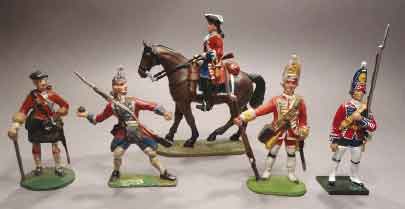
Picture 310D: The evolution of models of the 18th century
The foundations of the British Empire could well be said to have been laid in the Seven Years War, with Clive’s victory at Plassey and Wolfe’s Triumph at Quebec. Why, then, were manufacturers so seemingly reluctant to make models of this period? Still, now that the ‘special relationship’ with the US seems to be well established, there seems to be less reluctance to reprise the American War of Independence (or to put it the American way, the American Revolution), and that has been the springboard for Britains, a now thoroughly American brand, to fill in the gaps, and at least cover the Quebec end of the Year of Victories (1757). Here can be seen some of the few models of the 18th century that precede Britains recent proliferation. Left to right, Carman’s Bonnie Prince Charlie, an Erikssen British grenadier doing what they did, i.e. throw grenades, a Del Prado British Dragoon, a Stadden designed Cavendish Miniatures plastic grenadier and Britains 43004, Grenadier, 1st Foot Guards, created in 2006. O
Victoria Cross Series, Crimean War 2006, Indian Mutiny 2007-2008
The Victoria Cross series seemed a little confused, in that some parts of the content depicted general participants (including the enemy) and some portrayed specific occasions on which individuals won the Victoria Cross. The Crimean War side continued on from the Crimean War figures of 1997 to 2001 in the Limited Edition and Britains Toy Soldier series (see above). There was also a four set VC mini-series in the Premier range (see above).
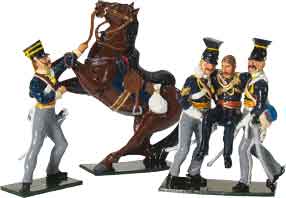
Picture 311: Saving Captain Webb
This triple VC vignette involves Captain Webb of the 17th Lancers being saved by sergeants Berryman and Farrell of the same regiment in the aftermath of the Charge of the Light Brigade at Balaclava. They are assisted by Corporal Malone of the 13th Light Dragoons, who is holding the horse. All three of these rescuers were awarded the VC, although Private Lamb of the 17th, who was with the party (not depicted), was given no award. B
Crimean War character figures:
43071 Queen Victoria mounted, presenting the first Victoria Cross to Commander Raby 2006
43071 Commander Henry James Raby VC, Royal Navy, with Queen Victoria 2006
43072 Captain Robert James Loyd-Lindsay VC ‘Defending the Colours’, Alma 2006
43073 Captain Webb ‘Saving Captain Webb’ with horse and rescuers 2006
43073 Sergeant Berryman VC ‘Saving Captain Webb’ with horse and rescuers 2006
43073 Sergeant Farrell VC ‘Saving Captain Webb’ with horse and rescuers 2006
43073 Corporal Malone VC ‘Saving Captain Webb’ with horse and rescuers 2006
43074 Lieutenant John Augustus Connolly VC with Russian soldier, Inkerman 2006
43085C Florence Nightingale with wounded and comrade 2006
43012 Captain Louis Edward Nolan mounted 2007
Indian Mutiny character figures:
43090 Lieutenant Alfred Ffrench VC with Privates Irwin and Kenny, Secundra Bagh 2007
43090 Private Charles Irwin VC with Lt. Ffrench, and Private Kenny, Secundra Bagh 2007
43090 Private James Kenny VC with Lt. Ffrench and Private Irwin, Secundra Bagh 2007
43095 Lance Corporal John Dunlay VC with Private Peter Grant, Secundra Bagh 2007
43095 Private Peter Grant VC with Lance Corporal John Dunlay, Secundra Bagh 2007
43097 Private David MacKay VC fighting Sepoy Secundra Bagh 2007
43107 Colour Sergeant James Munro VC rescuing Captain Walsh, Secundra Bagh 2007
43107 Captain Walsh rescued by Colour Sergeant James Munro VC, Secundra Bagh 2007
43159 Lieut. Thomas Young VC, Royal Navy with gun and wounded crew, Lucknow 2007
43159 Able Seaman Hall VC, Royal Navy with gun and wounded crew, Lucknow 2007
43161 Captain William Peel VC, Royal Navy, Lucknow 2007
Note: Although Captain William Peel (son of Sir Robert Peel) is depicted on service in India, where he served at the relief of Lucknow, he won his VC at the Siege of Sevastopol in the Crimean War three years earlier.
Pictures 312 and 312A: VC series, Indian Mutiny
The action concentrates on Lucknow, where many VCs were won in the assault on the Secundra Bagh. On the left, set 43090, Lieutenant Alfred Ffrench VC with Privates Irwin and Kenny who also won Victoria Crosses. As members of the 53rd Regiment, they are wearing the distinctive ‘Havelock’ headgear with neck shade reminiscent of the iconic look of the French Foreign Legion. To the right, set 43107, Colour Sergeant James Munro VC rescues the wounded Captain Walsh of the 93rd (Sutherland) Highlanders on the same day. All twelve of the Lucknow sets were issued in 2007, making an intriguing cameo of a subject not too often covered, and nowhere else depicted by Britains. W
Life of Her Majesty Queen Elizabeth II 2006 only
The Queen’s 80th birthday was the excuse for a four figure series
43052 Princess Elizabeth in ATS uniform, WWII
43053 Queen Elizabeth showing her in coronation gown
43054 Queen Elizabeth in Garter robes
43055 Queen Elizabeth in State Dress, Opening of Parliament
Petticoats 2008-2012
Once more, Britains were hardly the first to produce ladies in period costume, and once again, their entry into this field was about as good as such figures can get. Ten figures were introduced over two years intended to add a feminine interest to the Redcoat and Bluecoat collection. Each lady covered a different trend in fashion starting from 1755 and ending in 1895.
Other Specials
Aside from the Collectors Club, various special figures were made for various special occasions, shows, dinners and organisations. From as early as 1993 many of these were made in various New Toy Soldier styles. Some made it into the catalogue, others remained exclusive, but most leaked out into the collector market not necessarily for huge premium prices.
In the 2013 120th anniversary Winter and Stock catalogue, the only remaining gloss series remaining are Ceremonial, Limited Edition, Archive and Redcoats and Bluecoats – all else has come to a conclusion.
